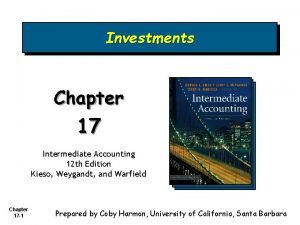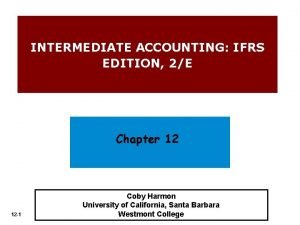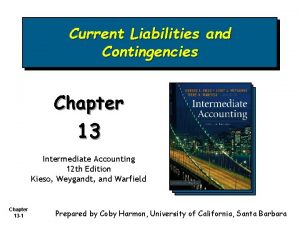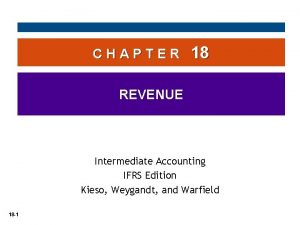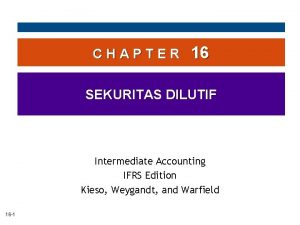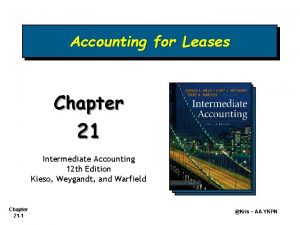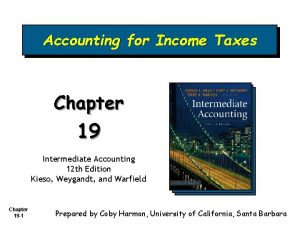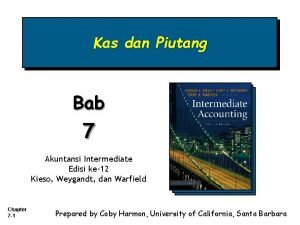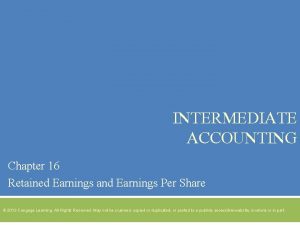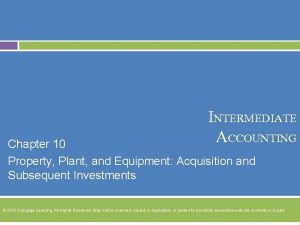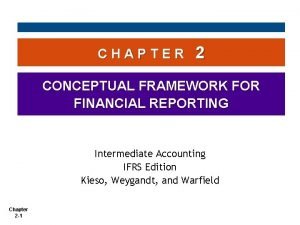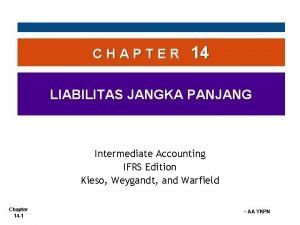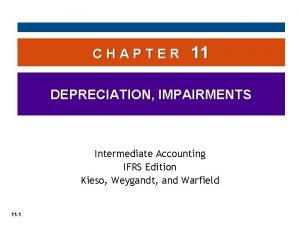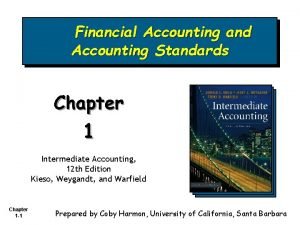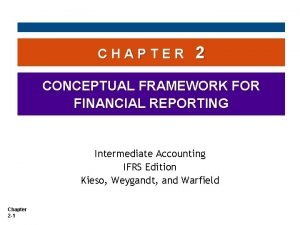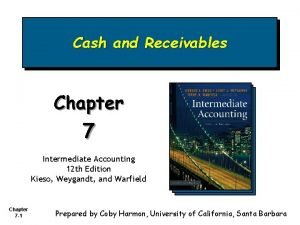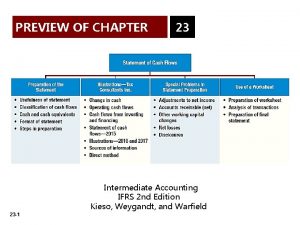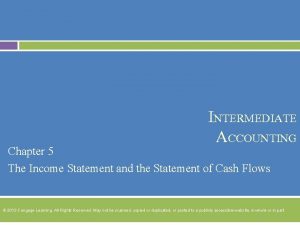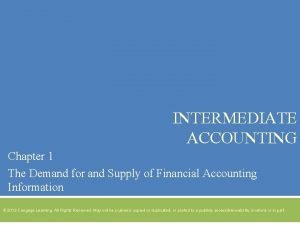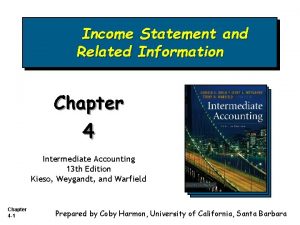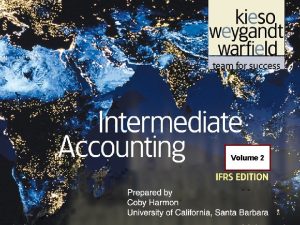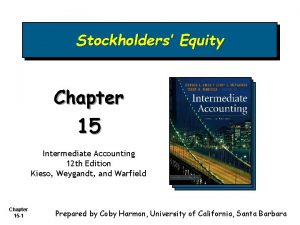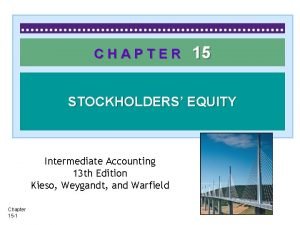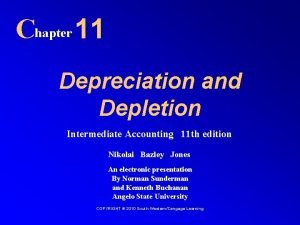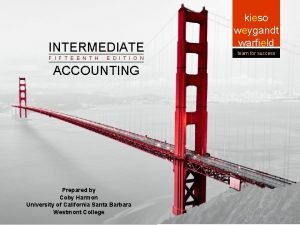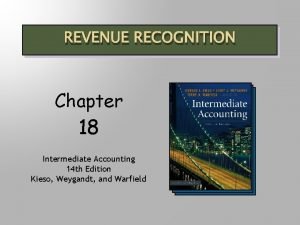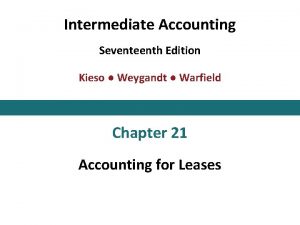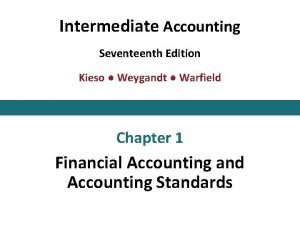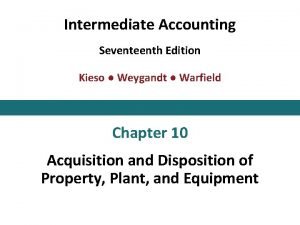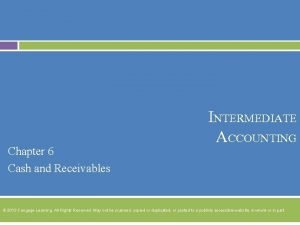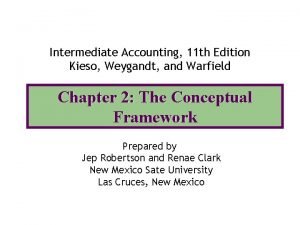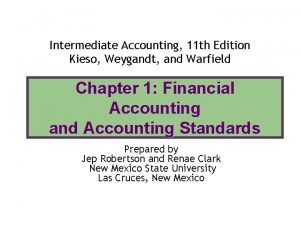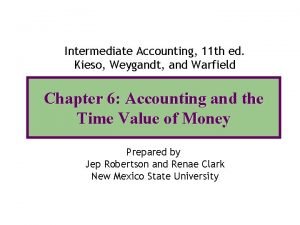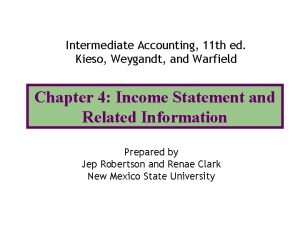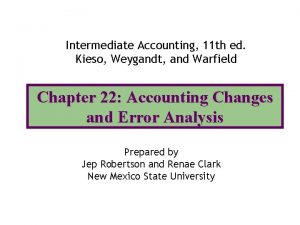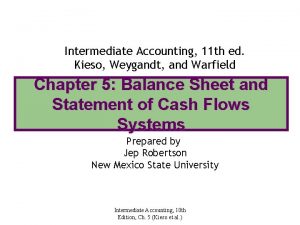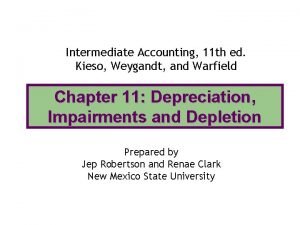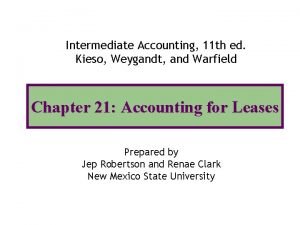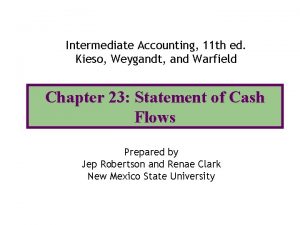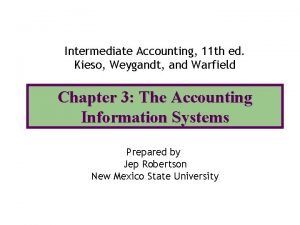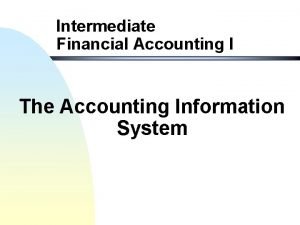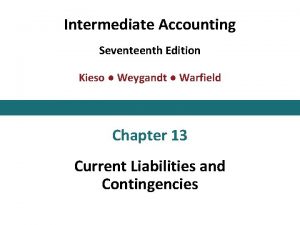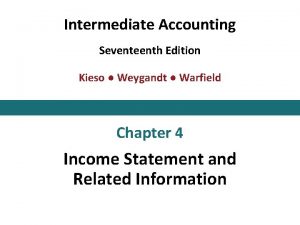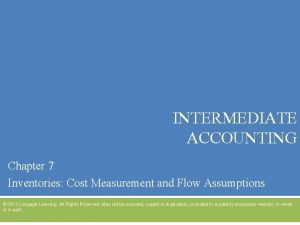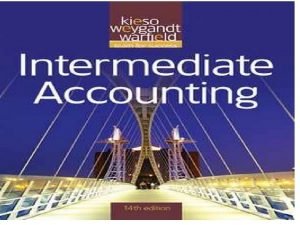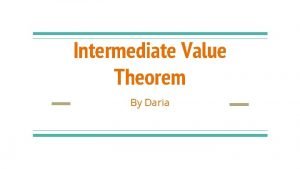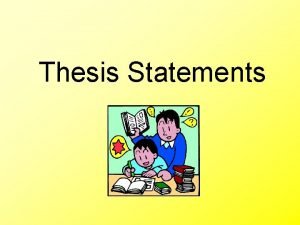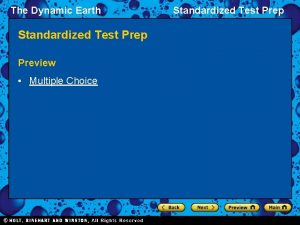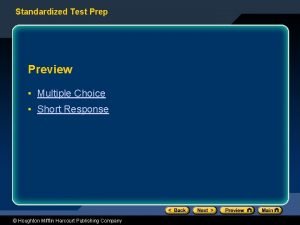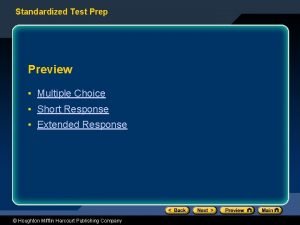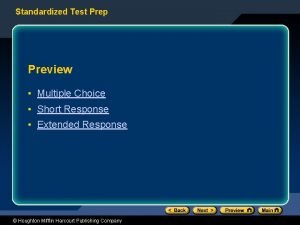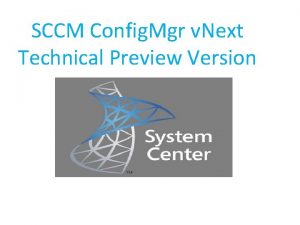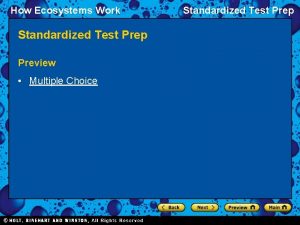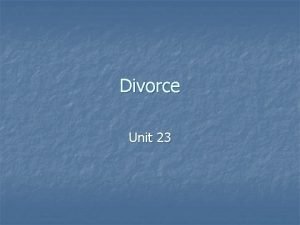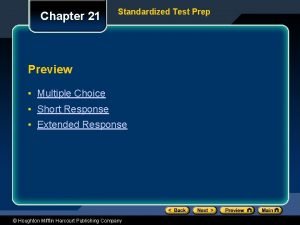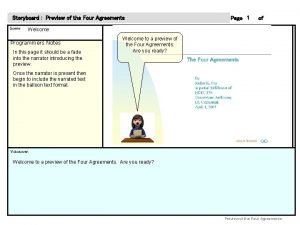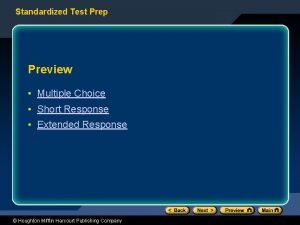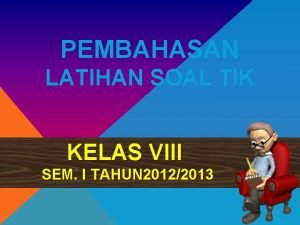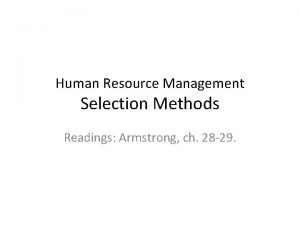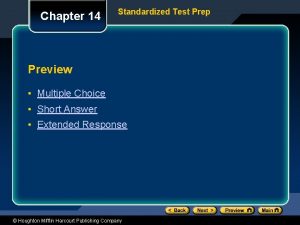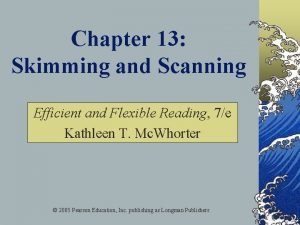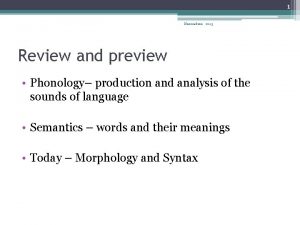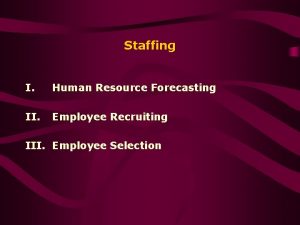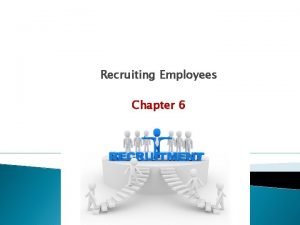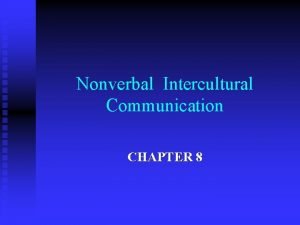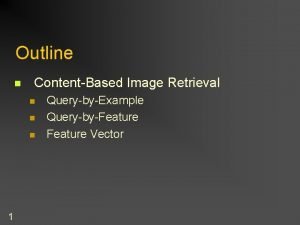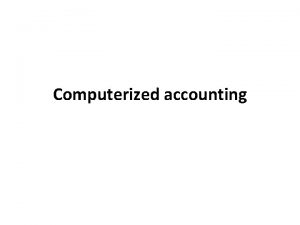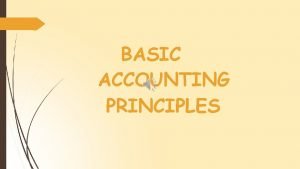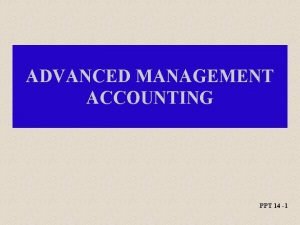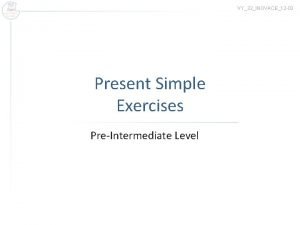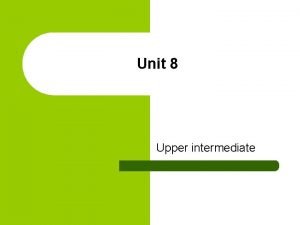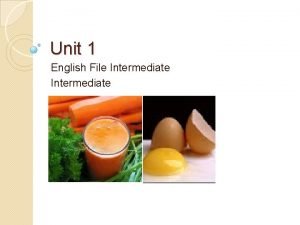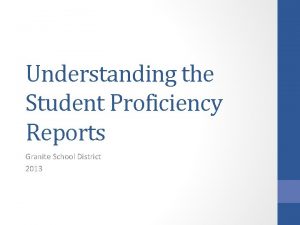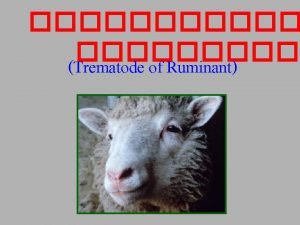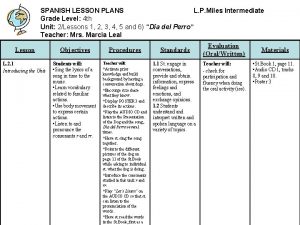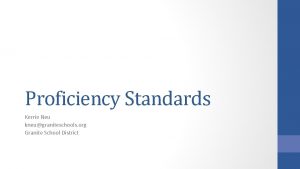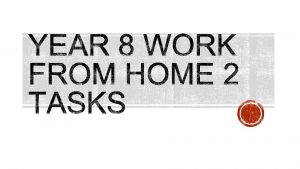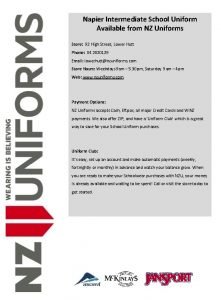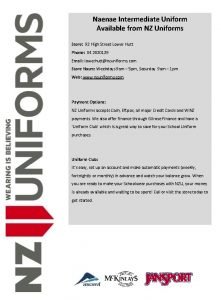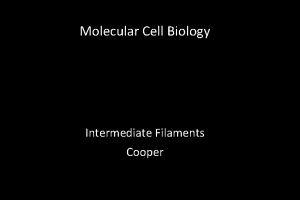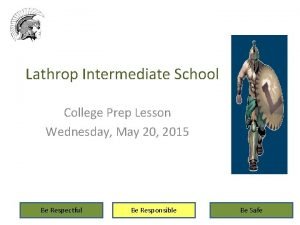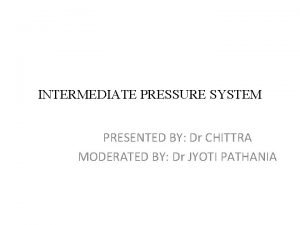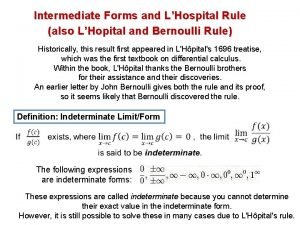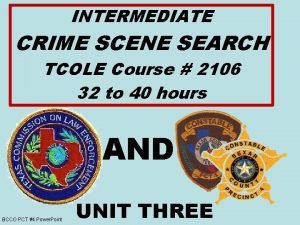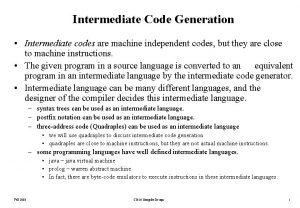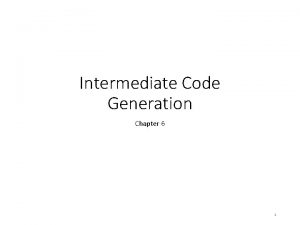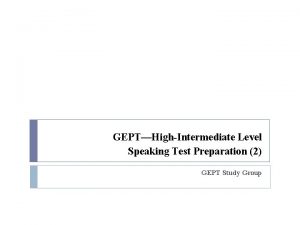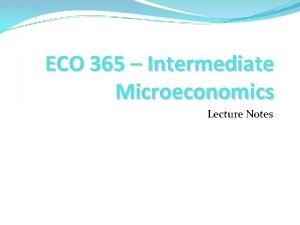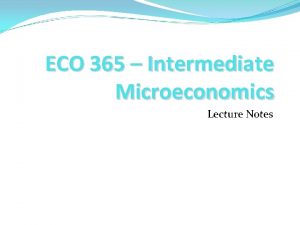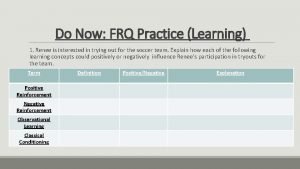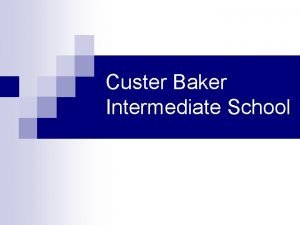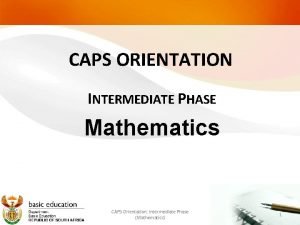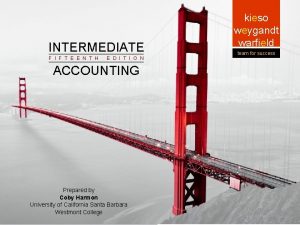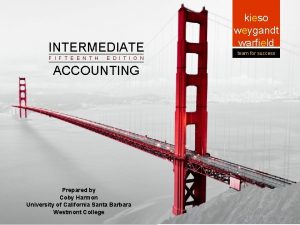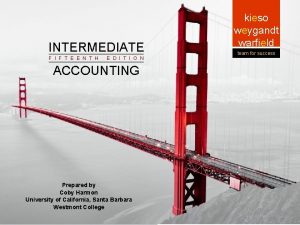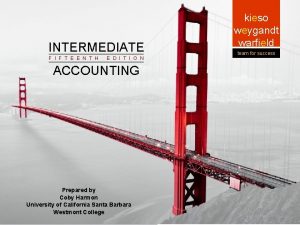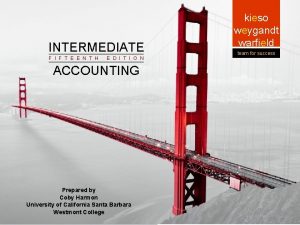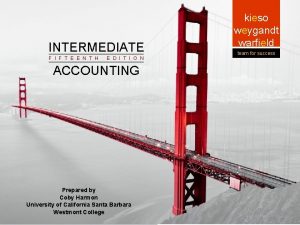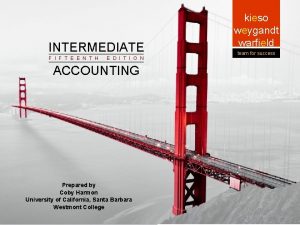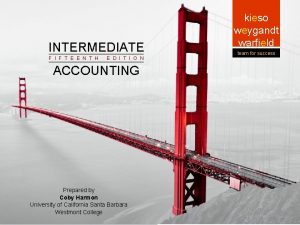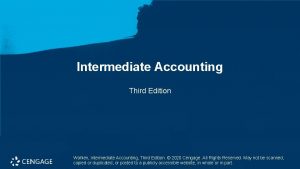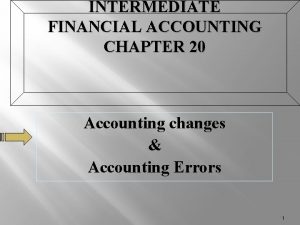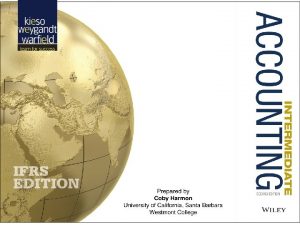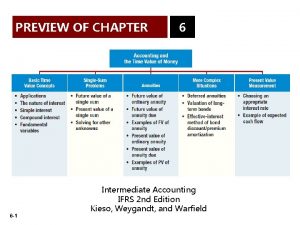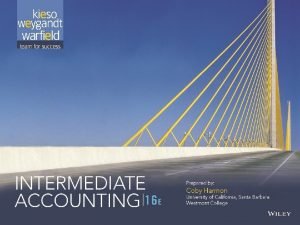18 1 PREVIEW OF CHAPTER 18 Intermediate Accounting


















































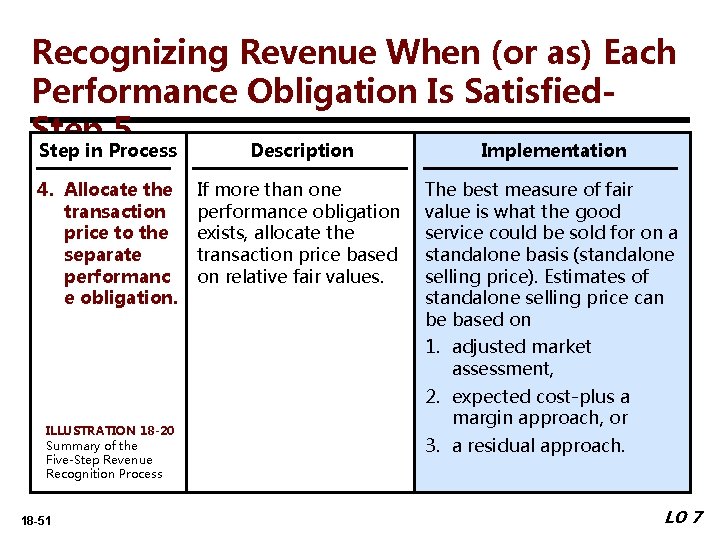
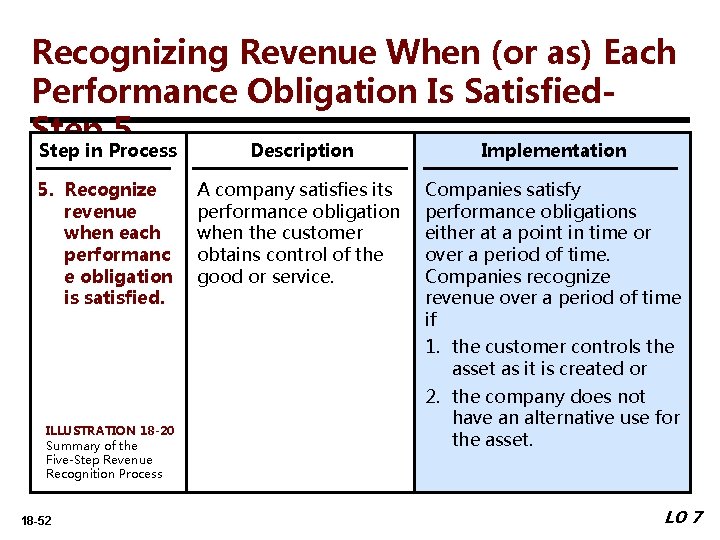
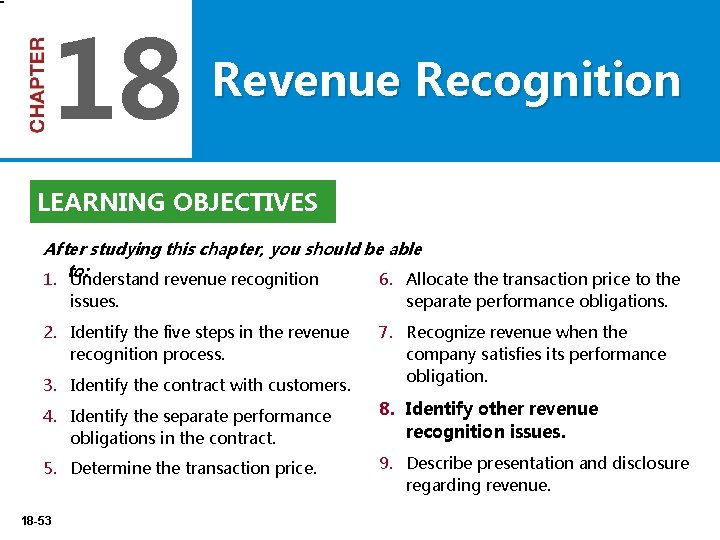
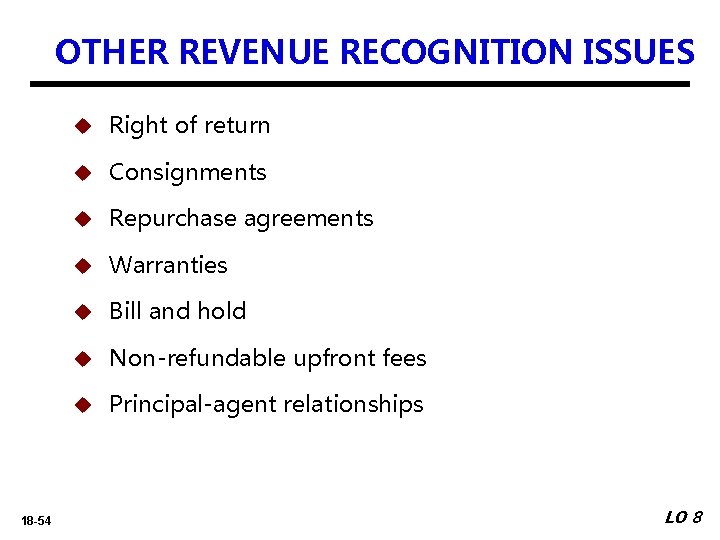
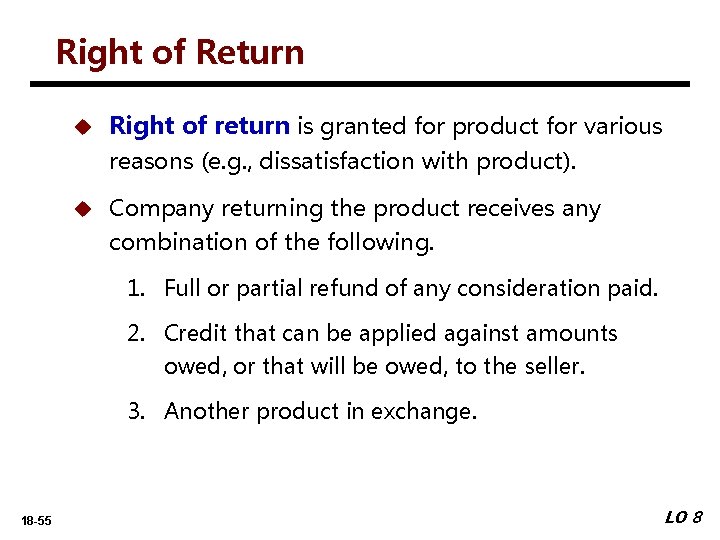
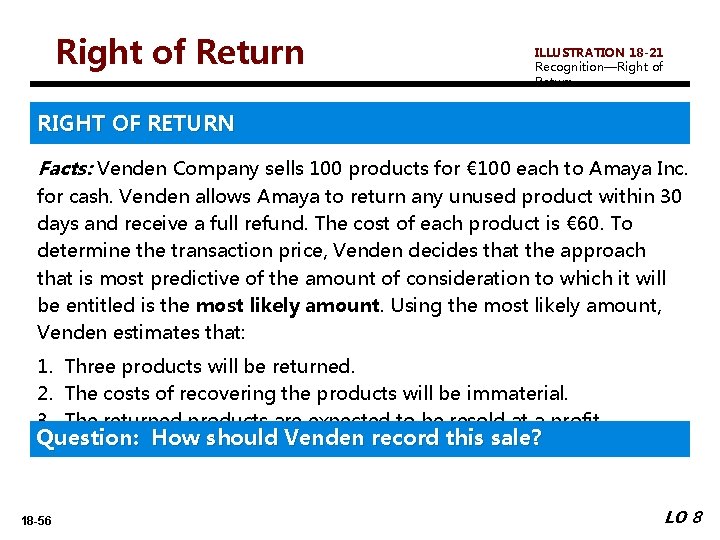
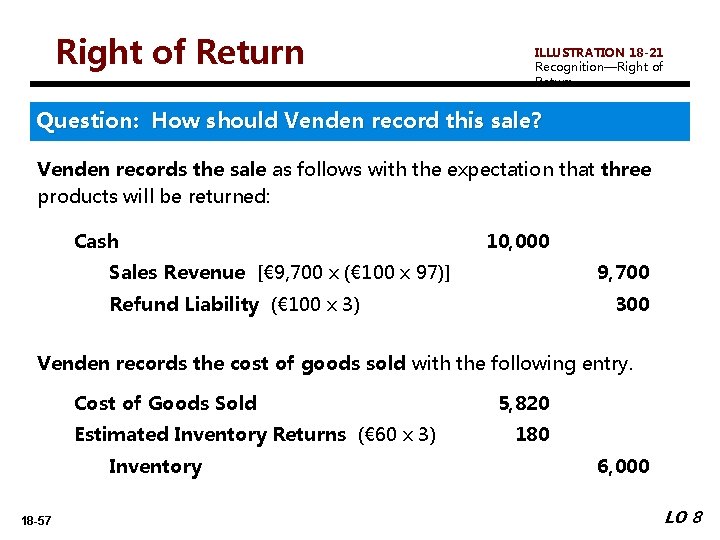
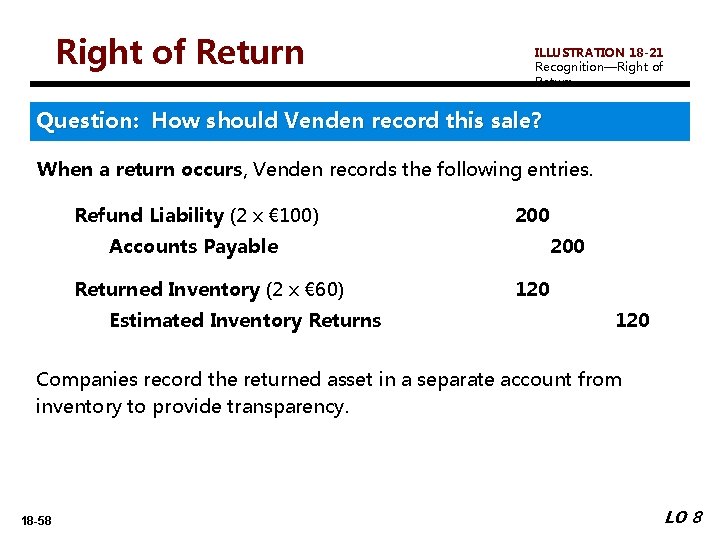
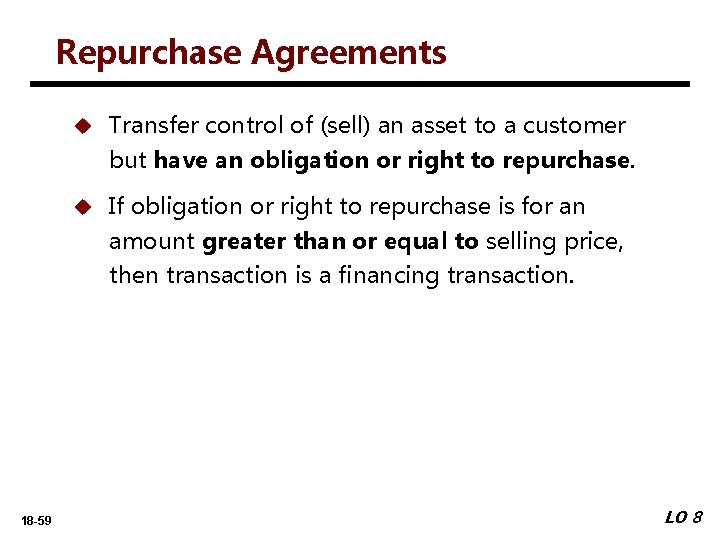
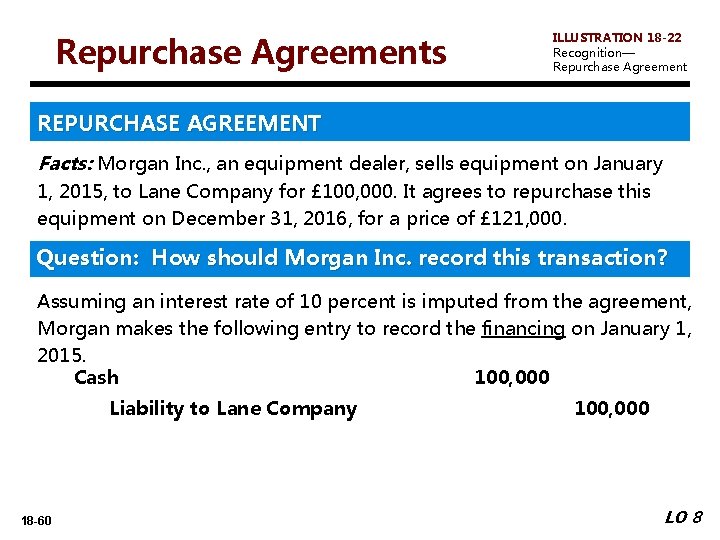
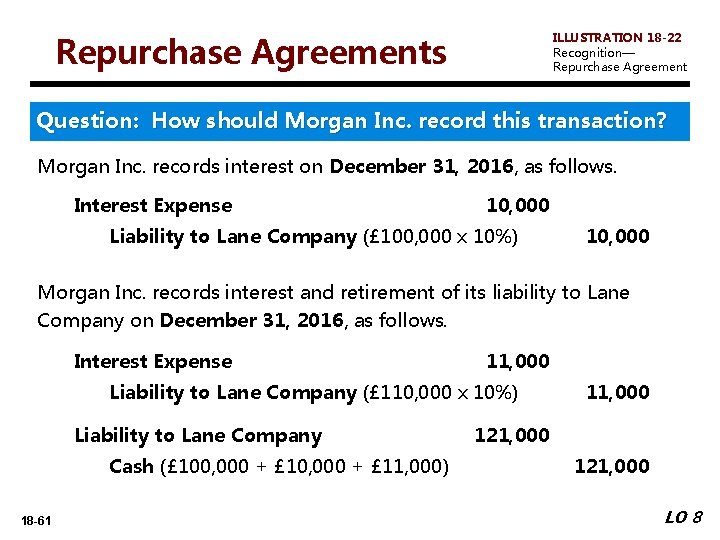
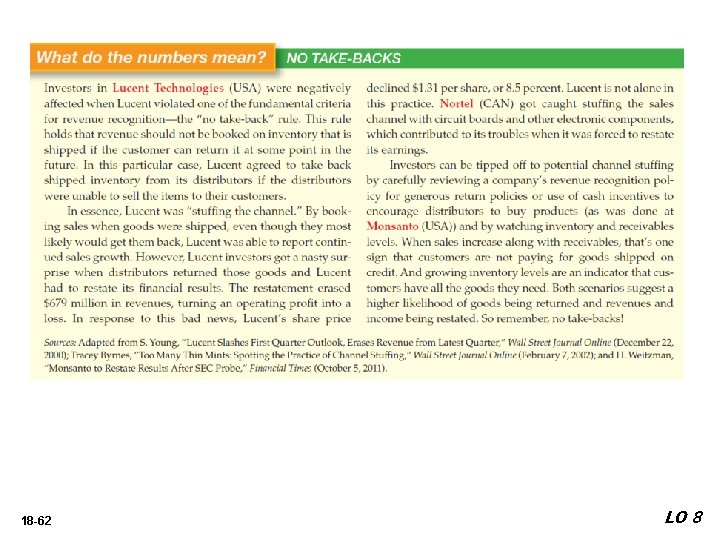
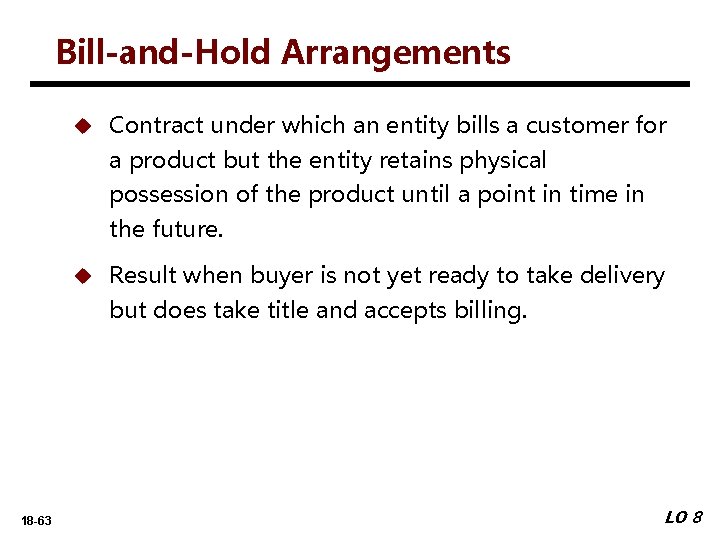
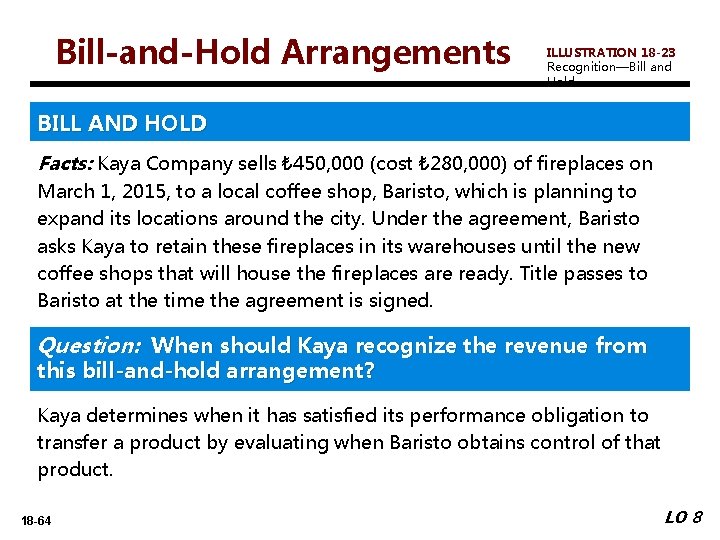
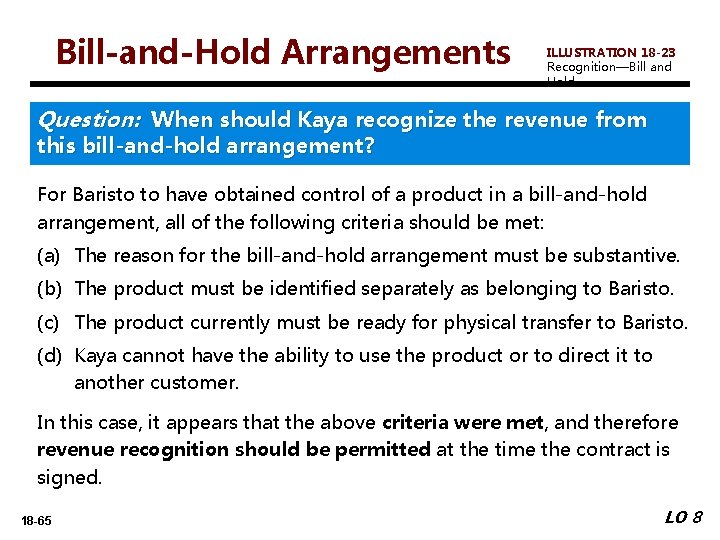
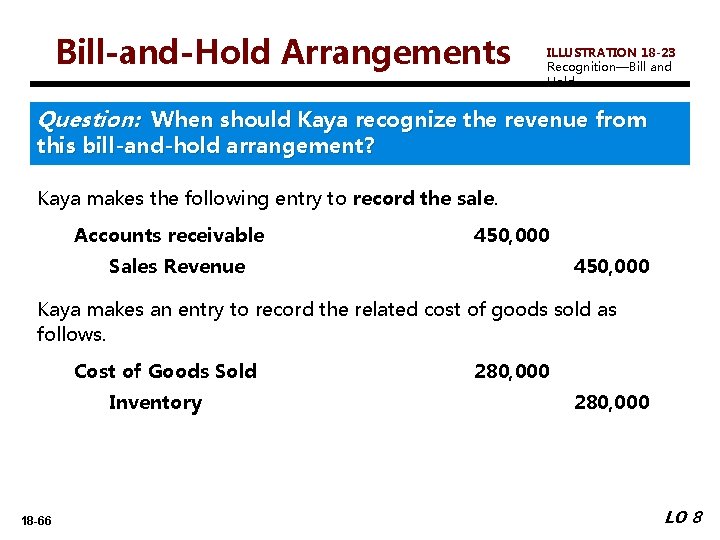
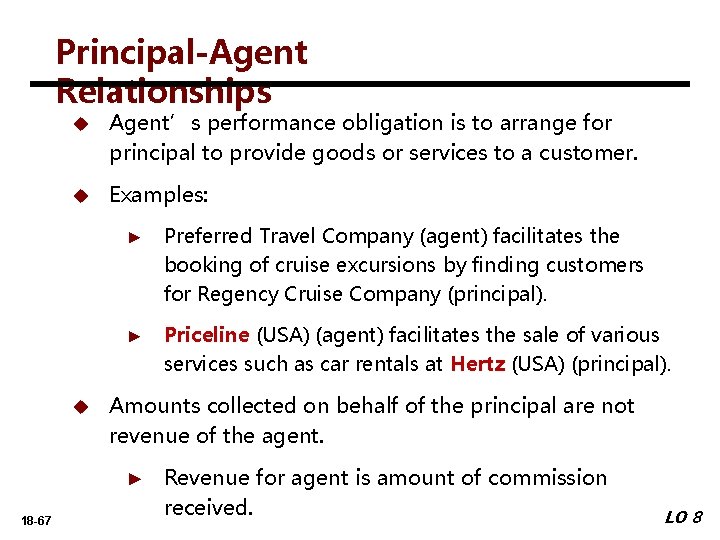
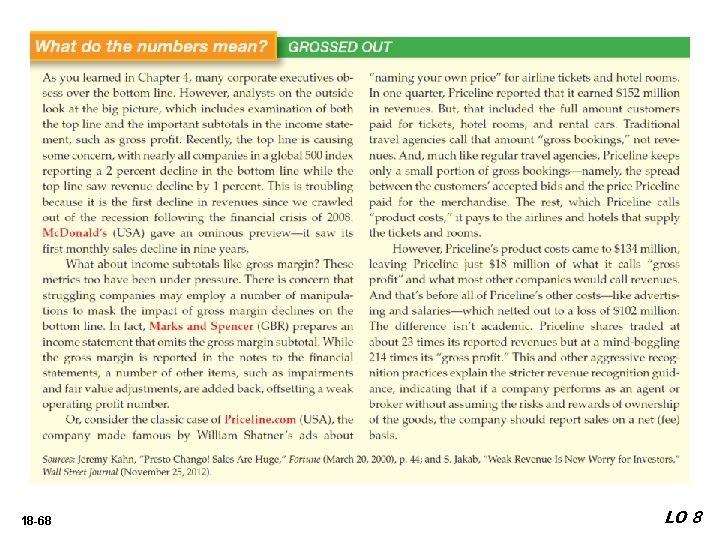
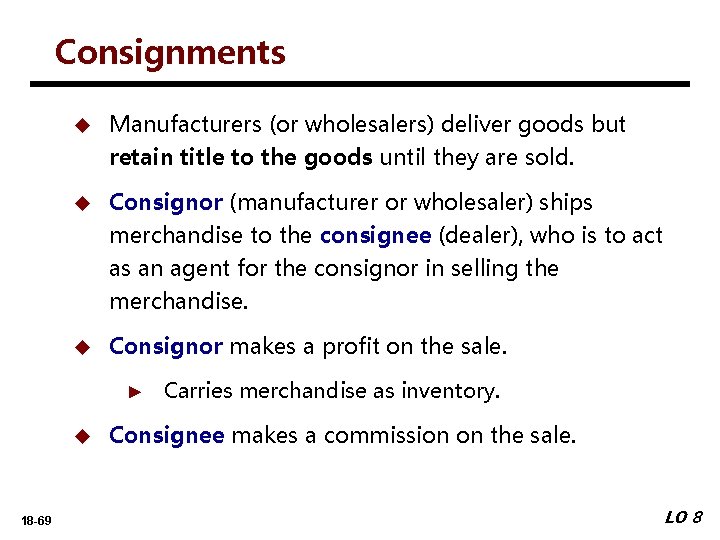
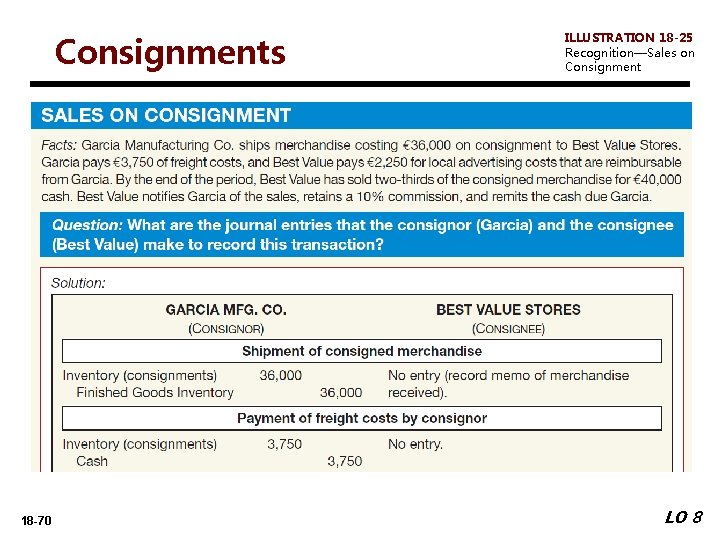
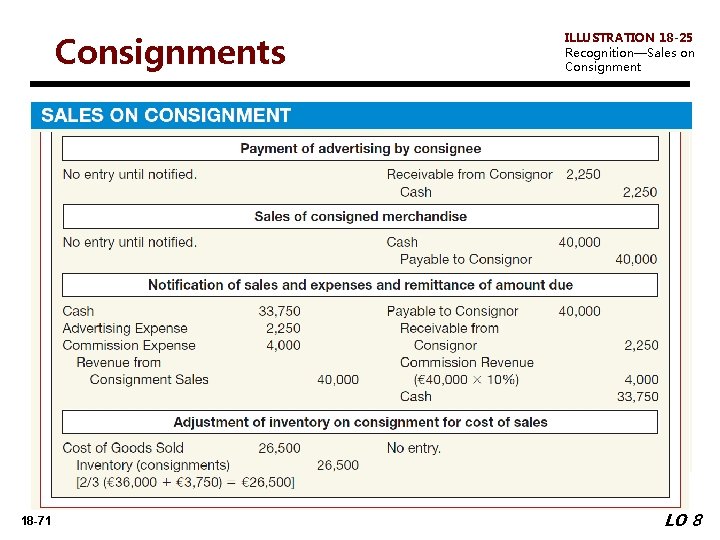
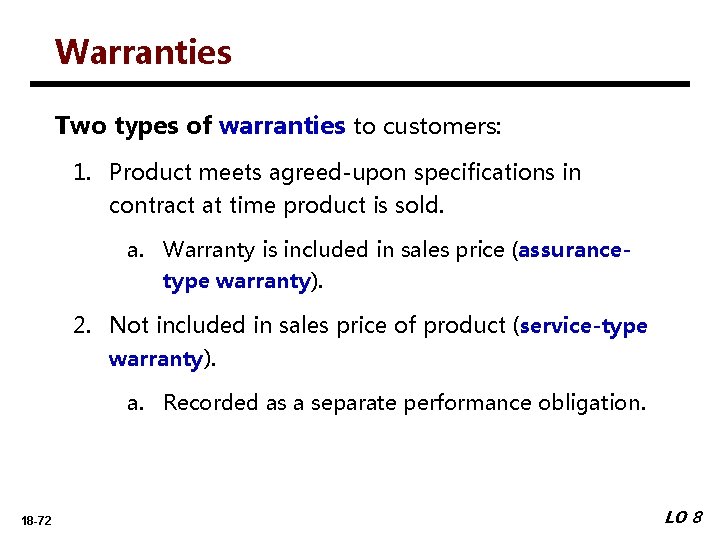
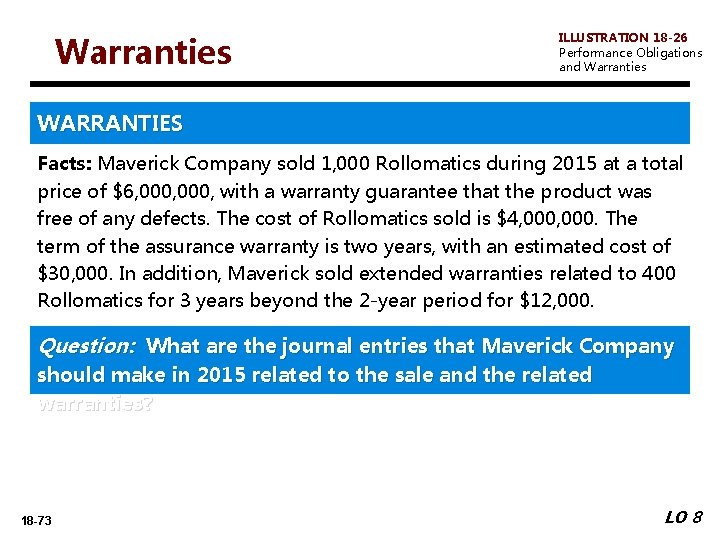
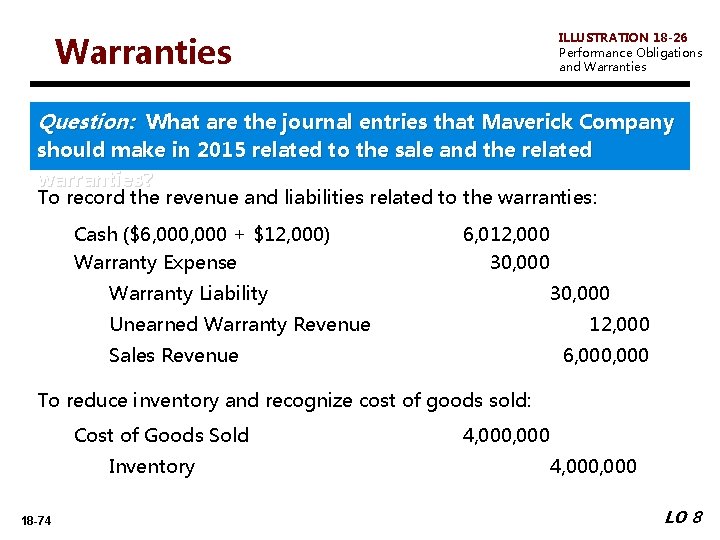
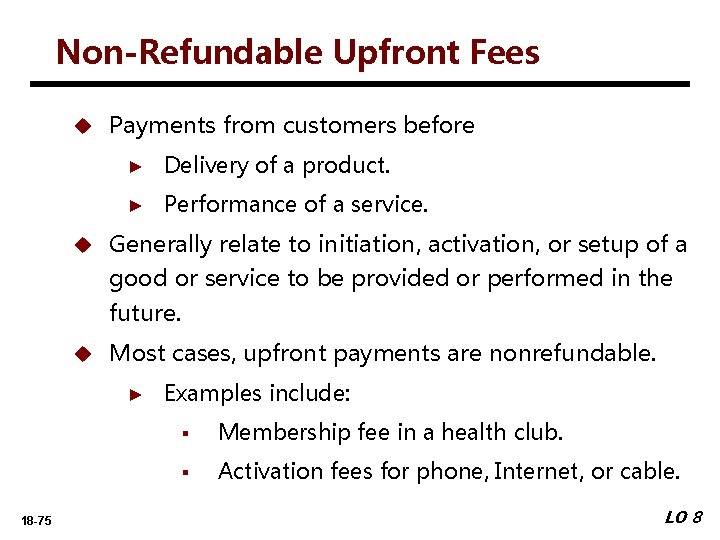
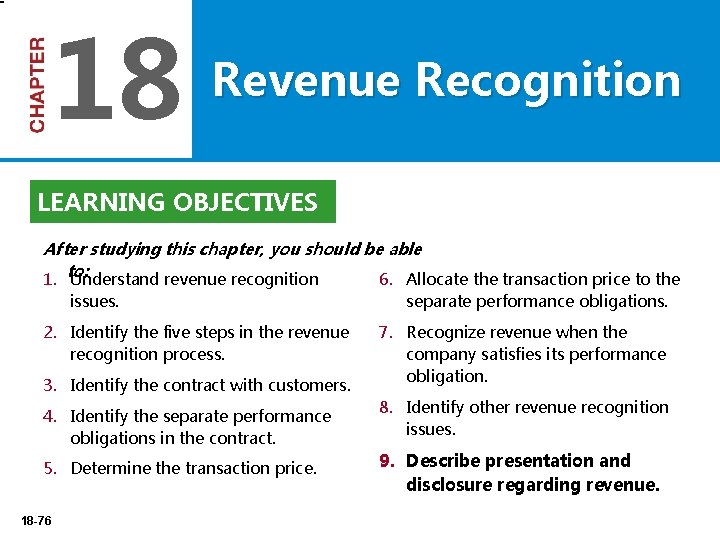
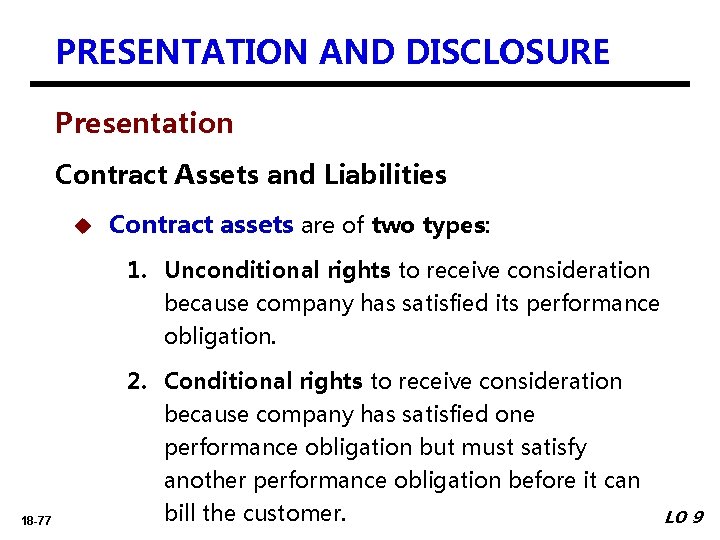
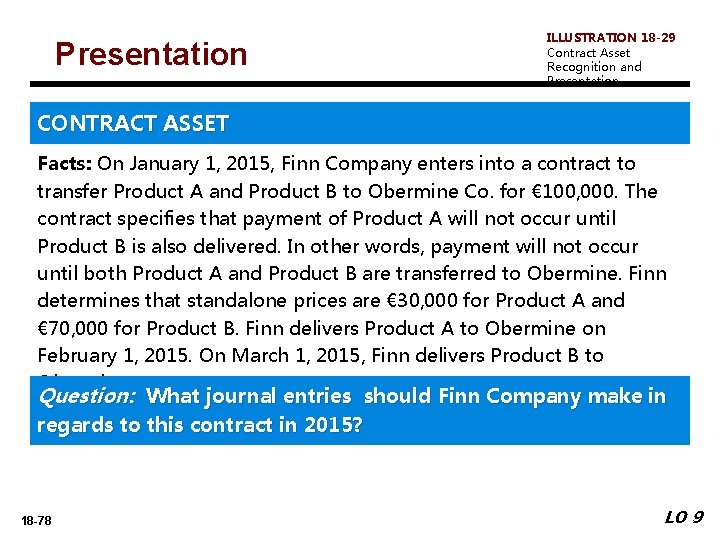
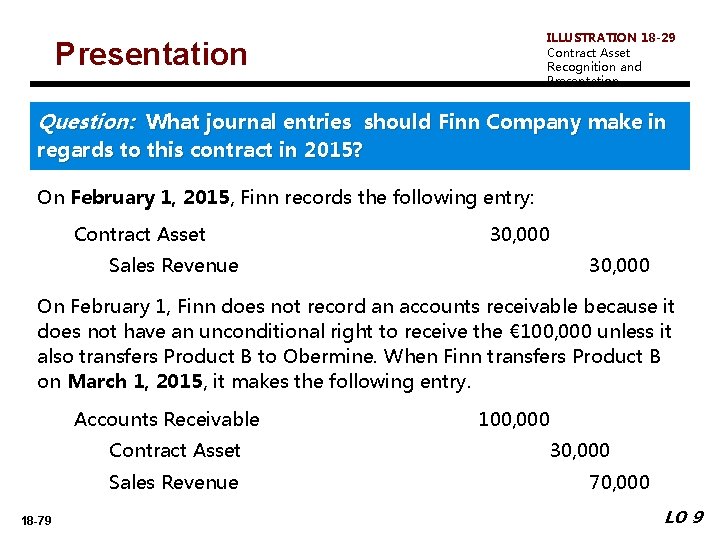
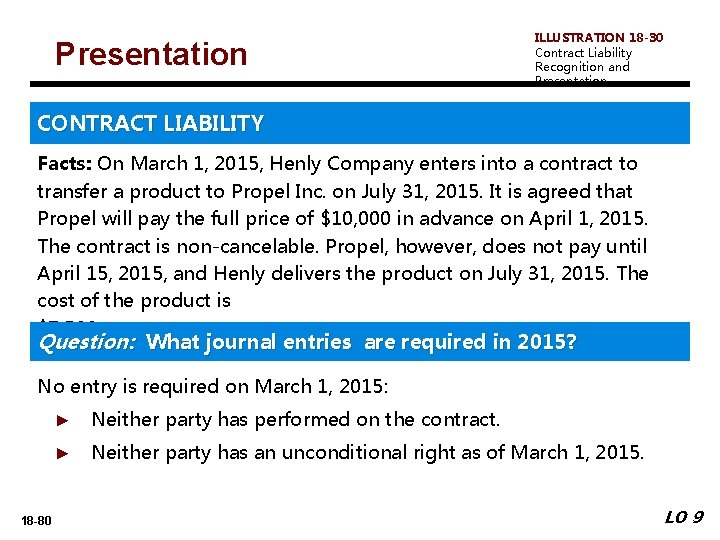
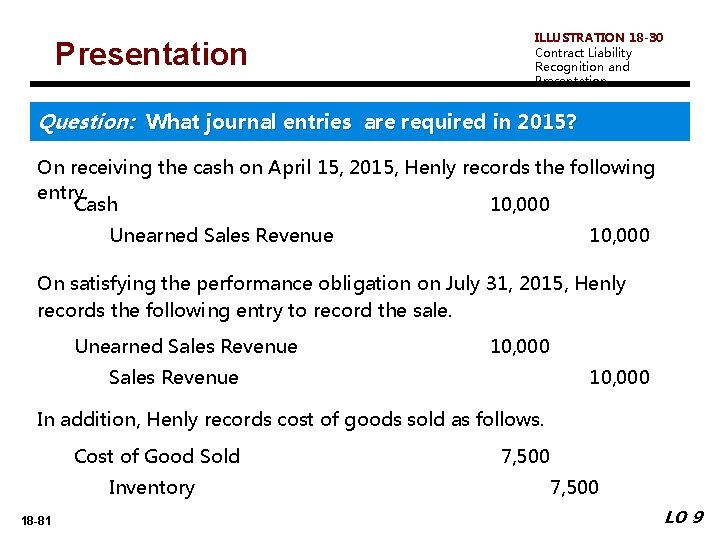
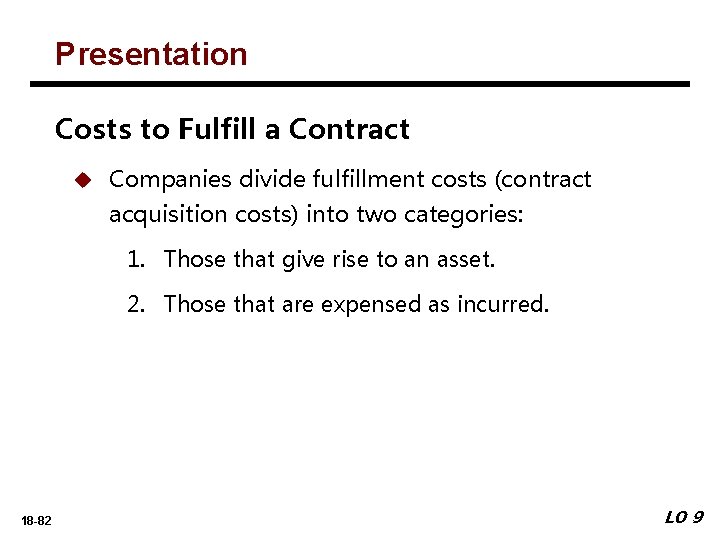
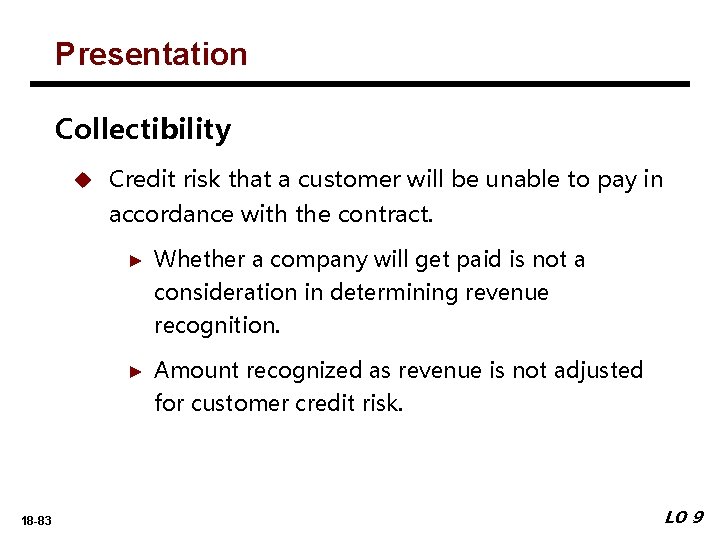
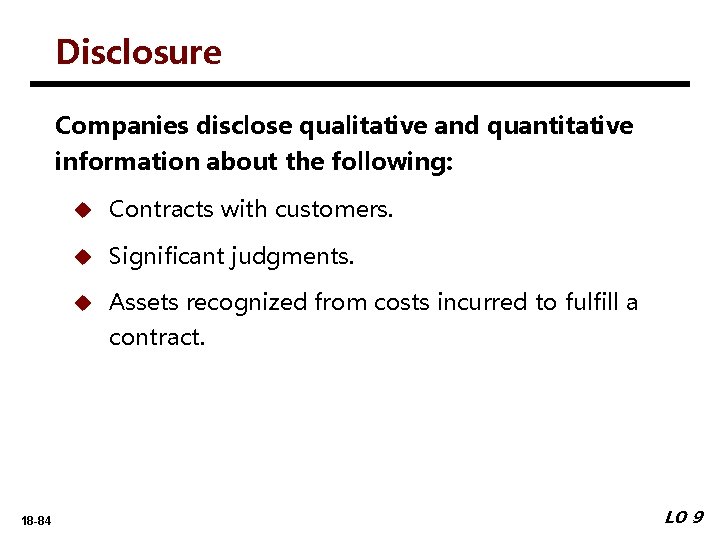
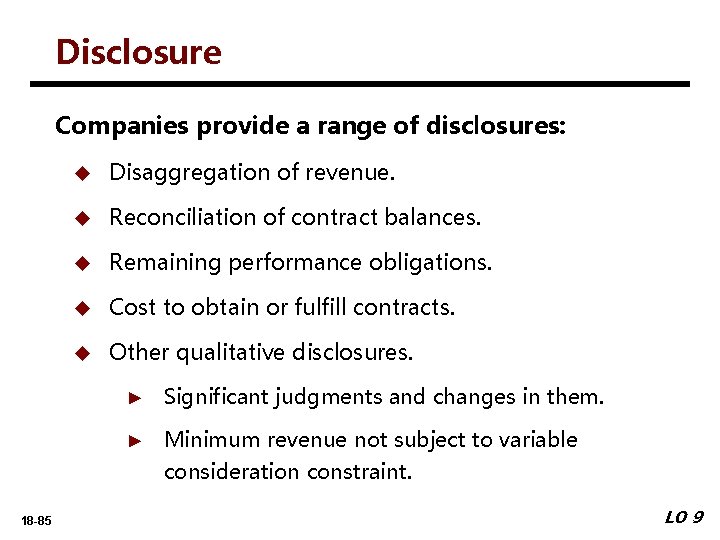
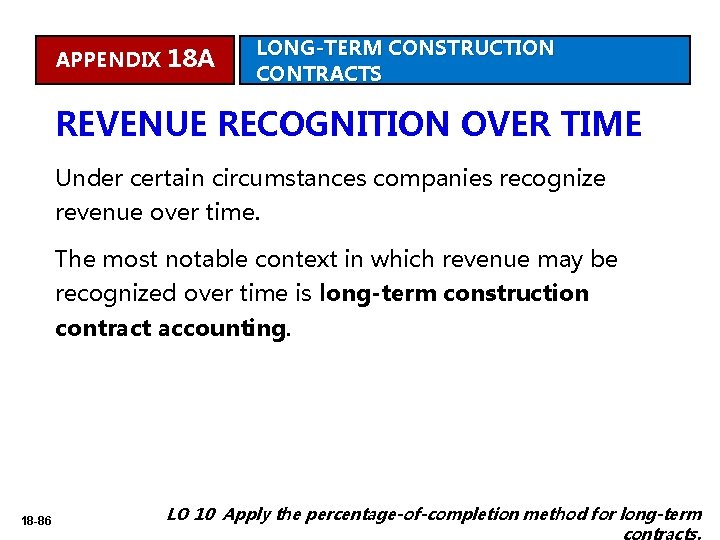
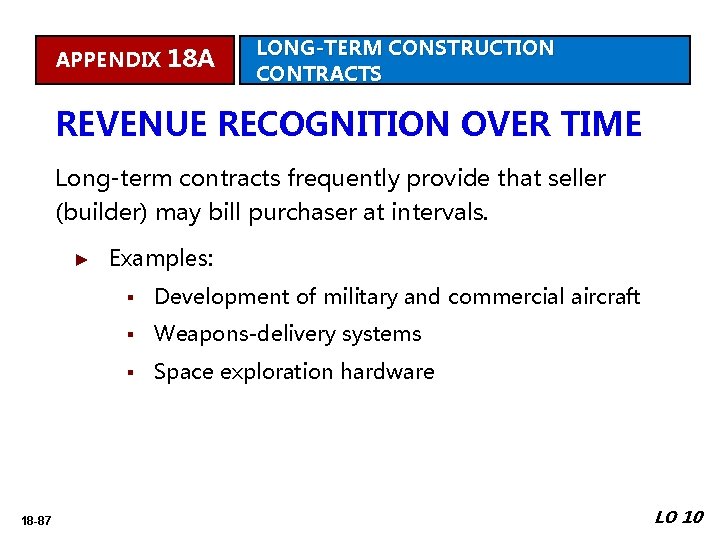
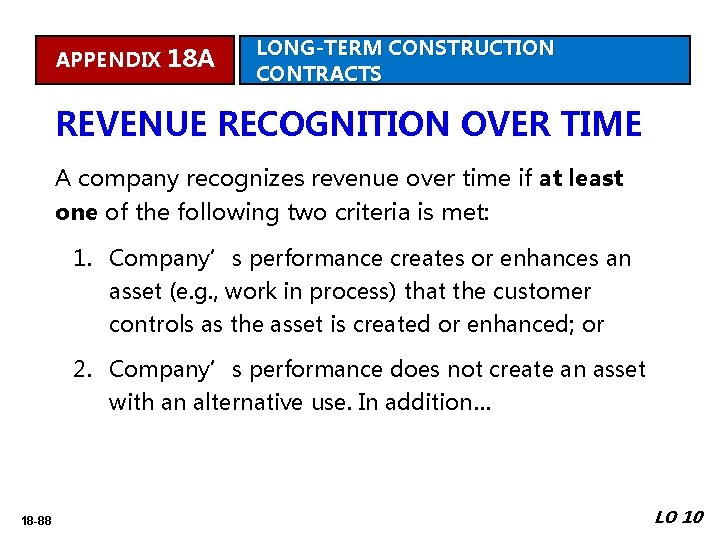
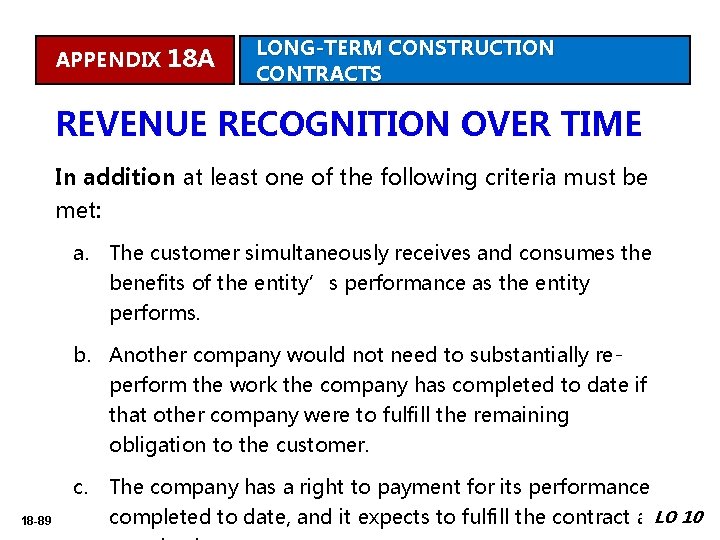
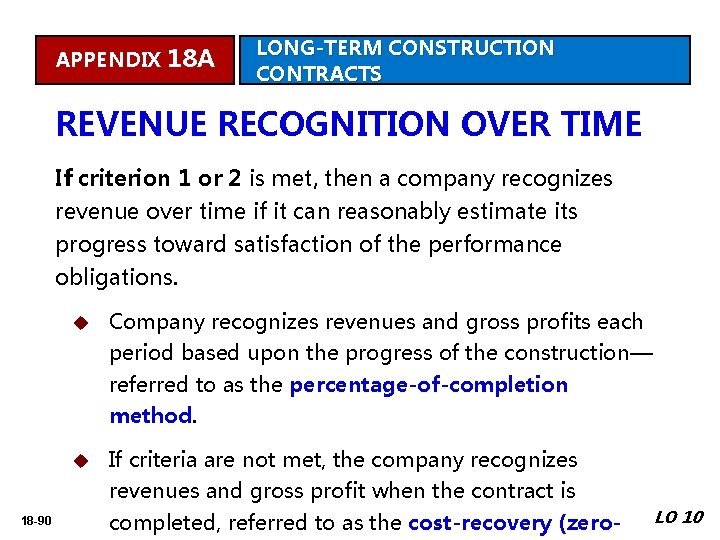
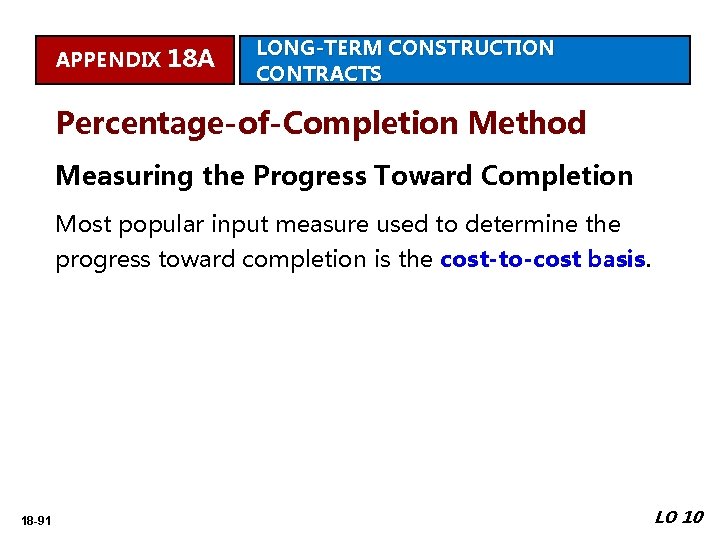
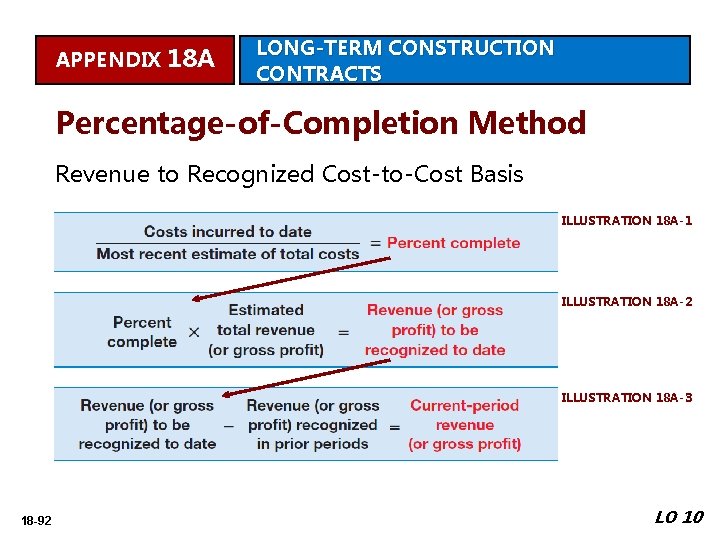
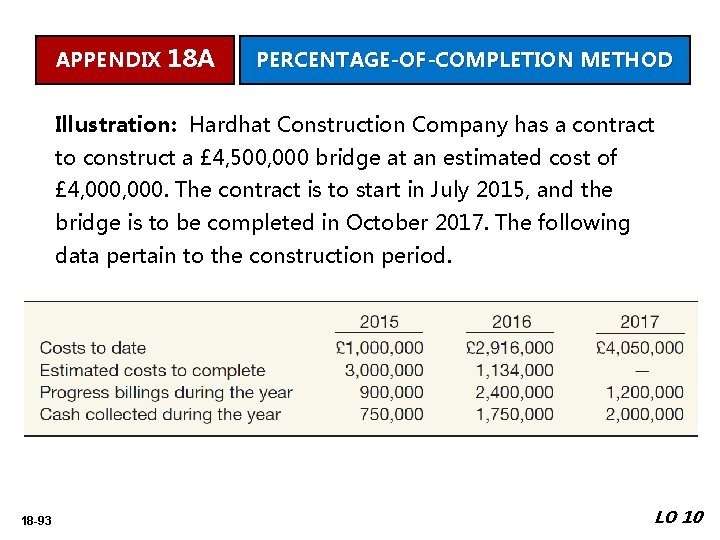
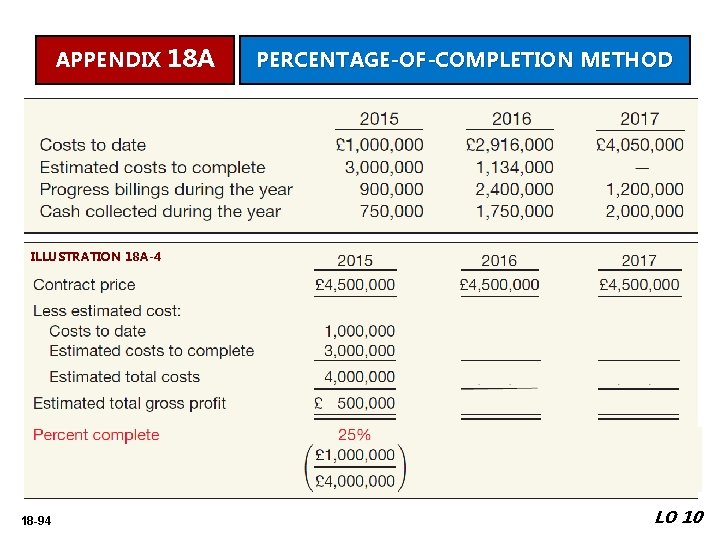
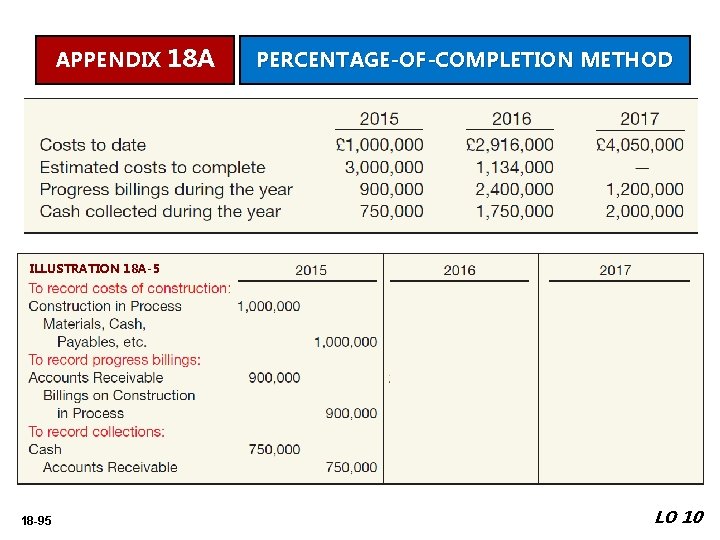
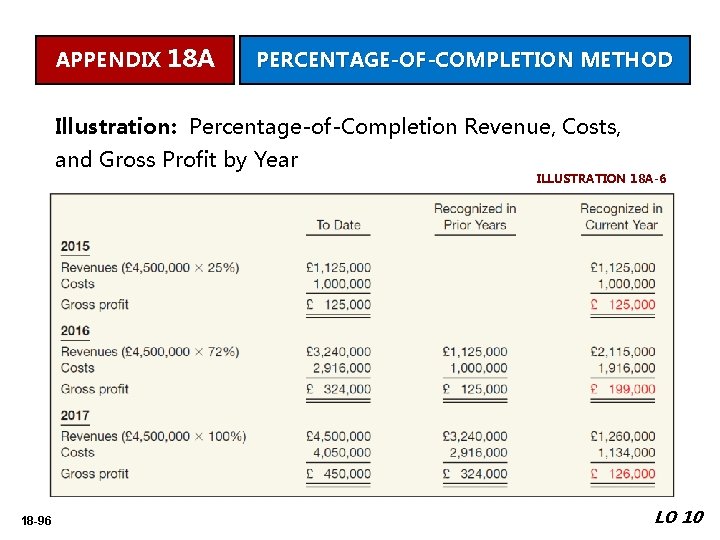
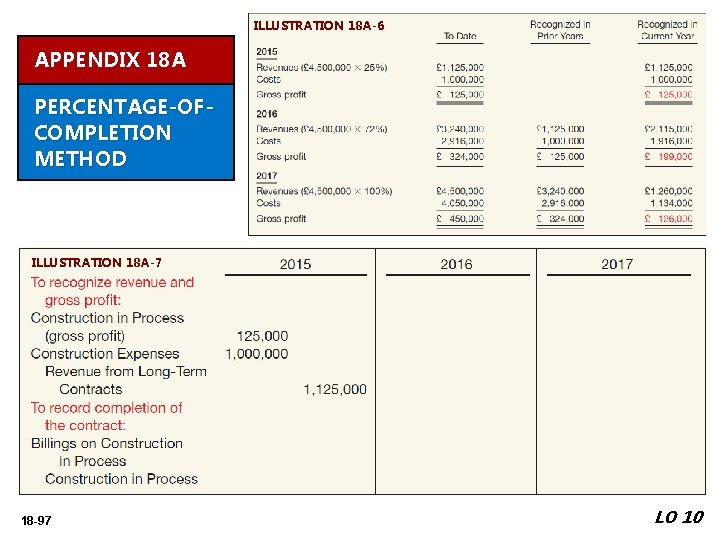
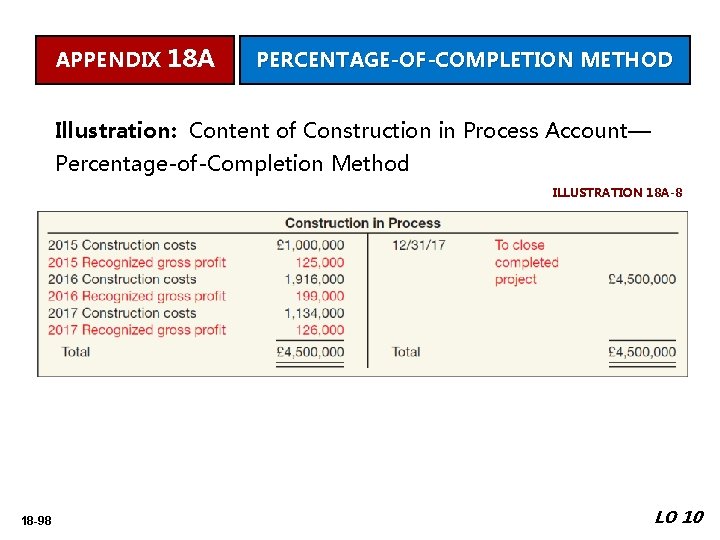
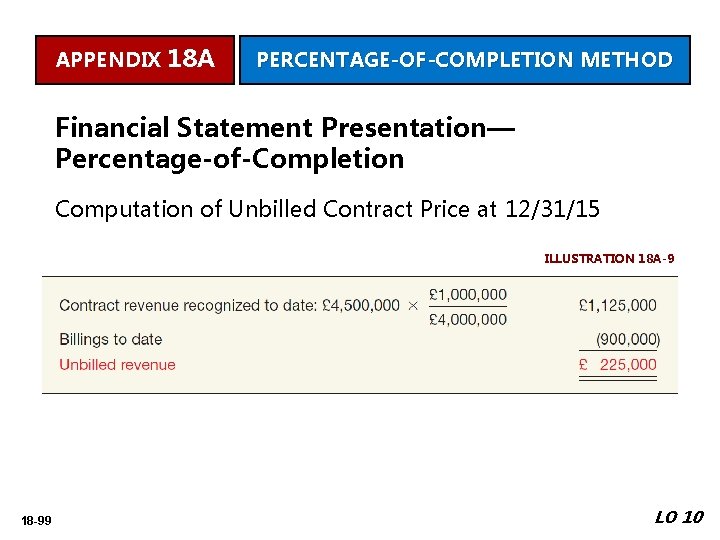
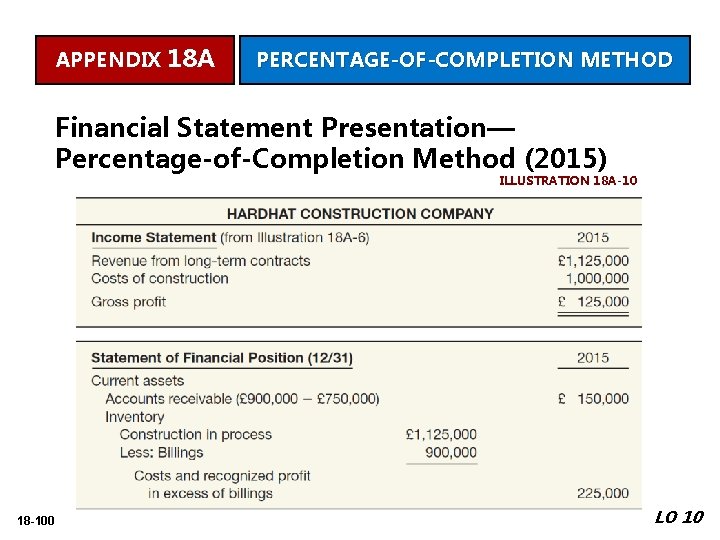
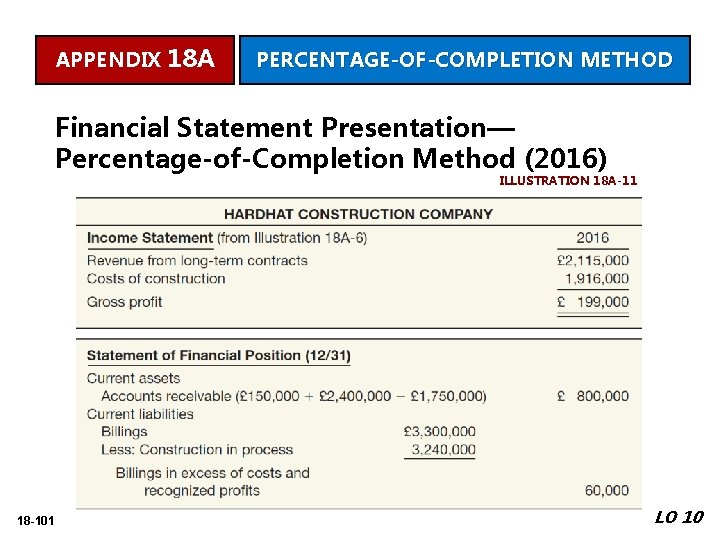
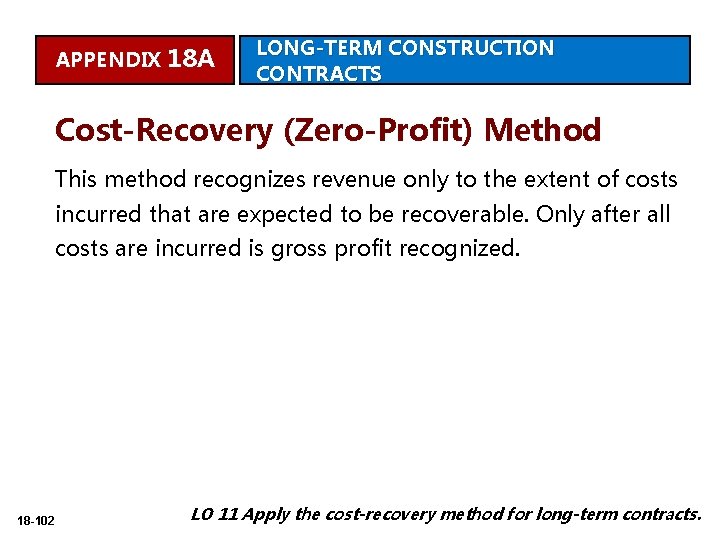
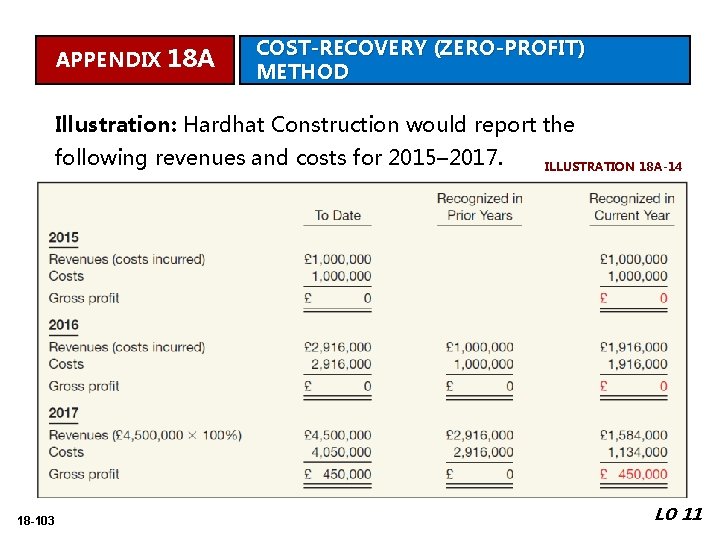
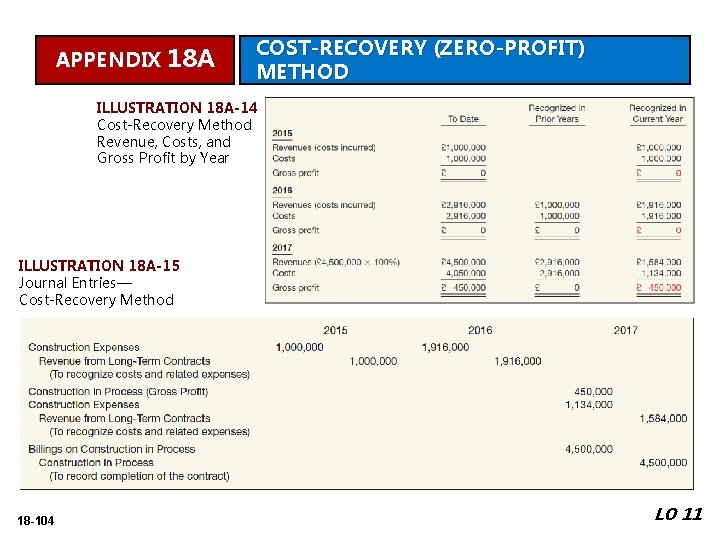
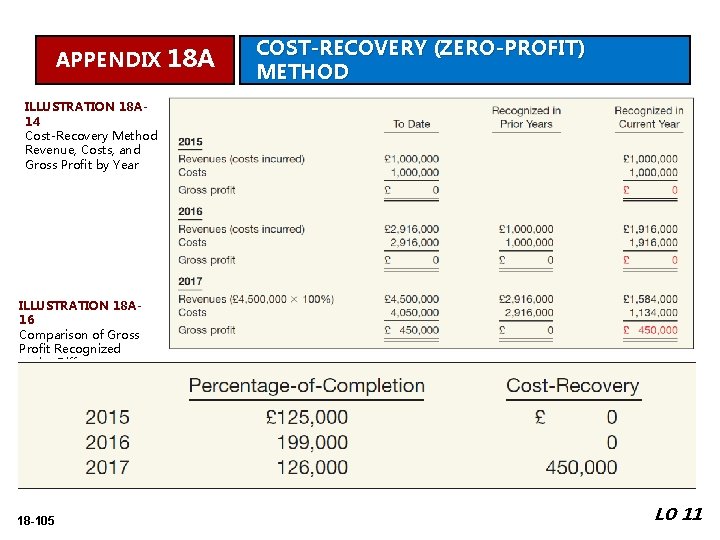
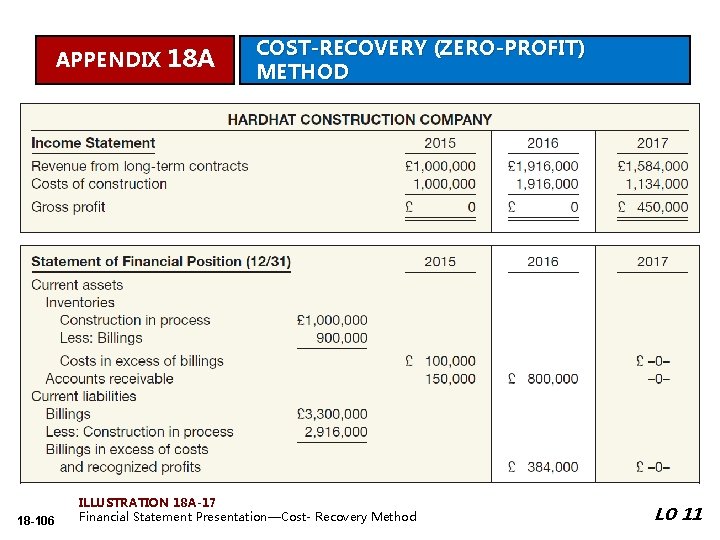
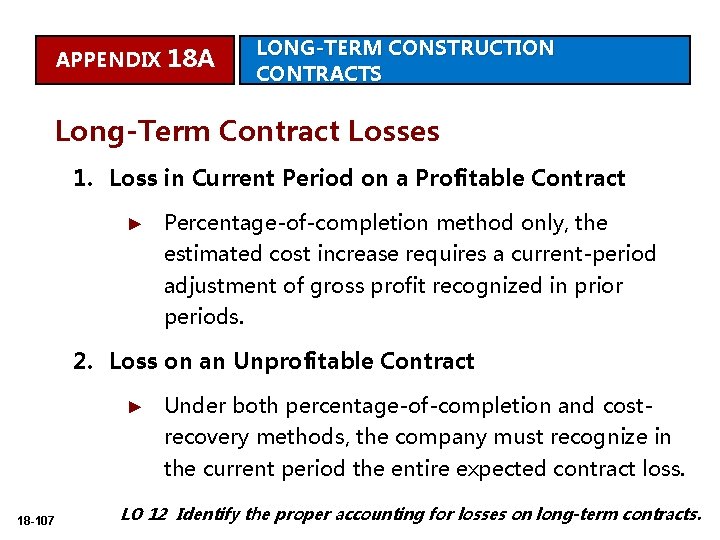
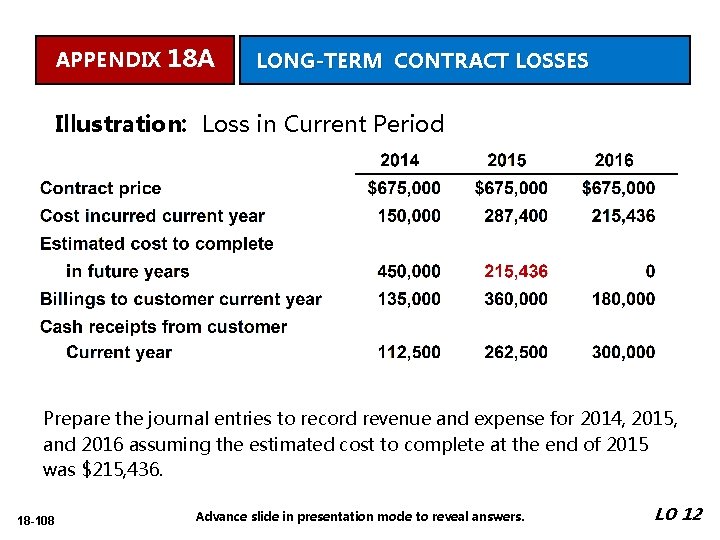
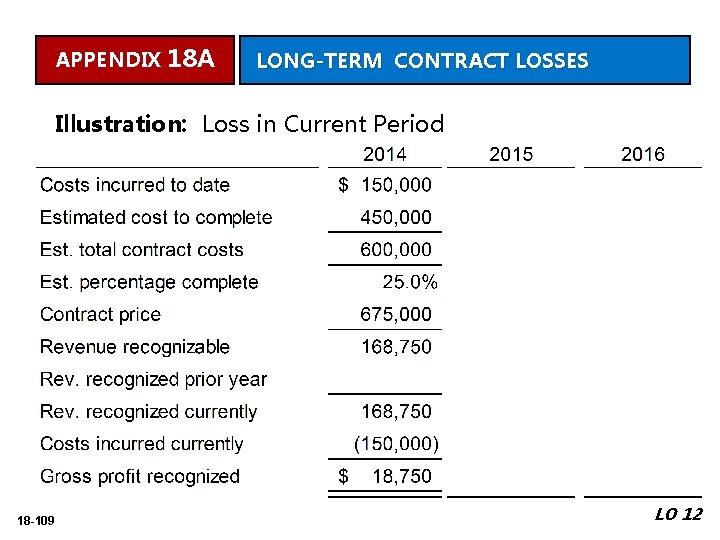
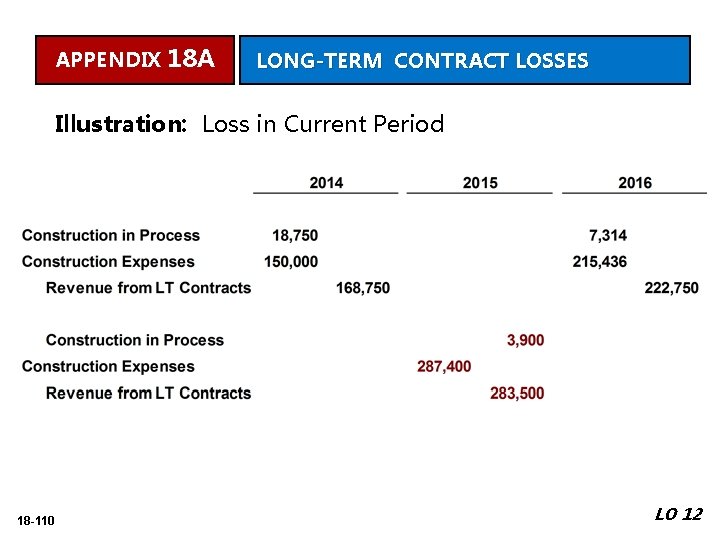
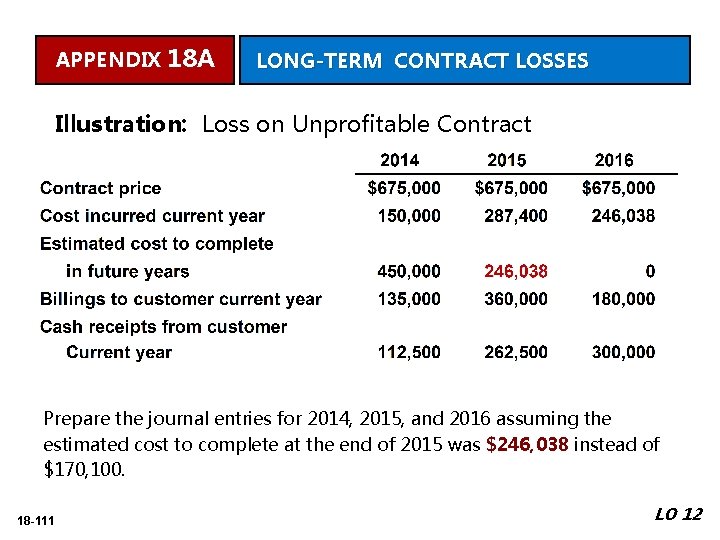
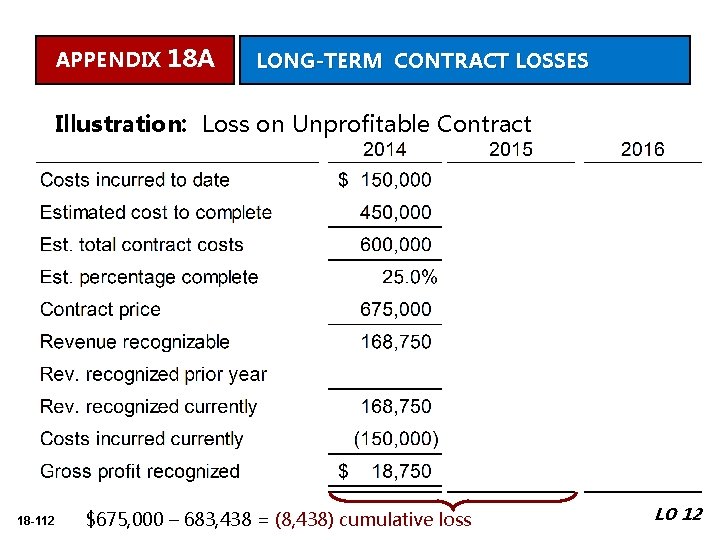
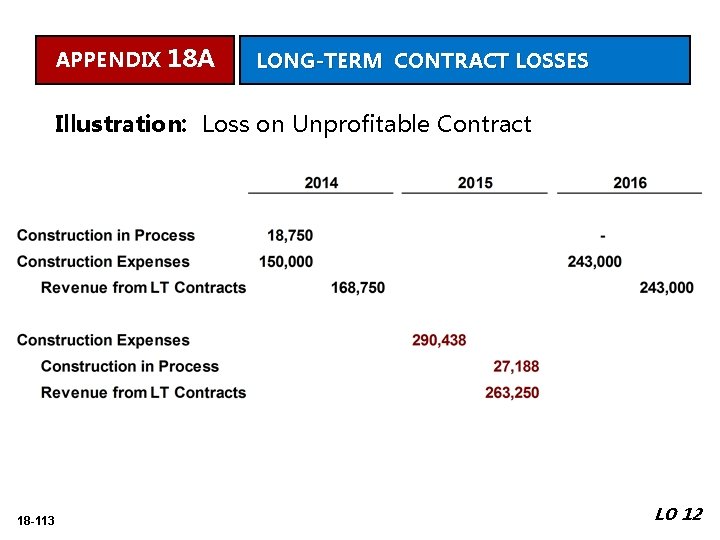
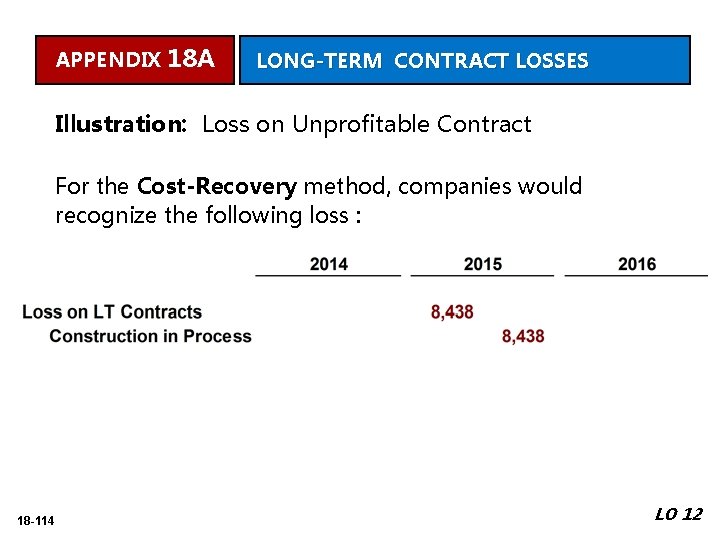
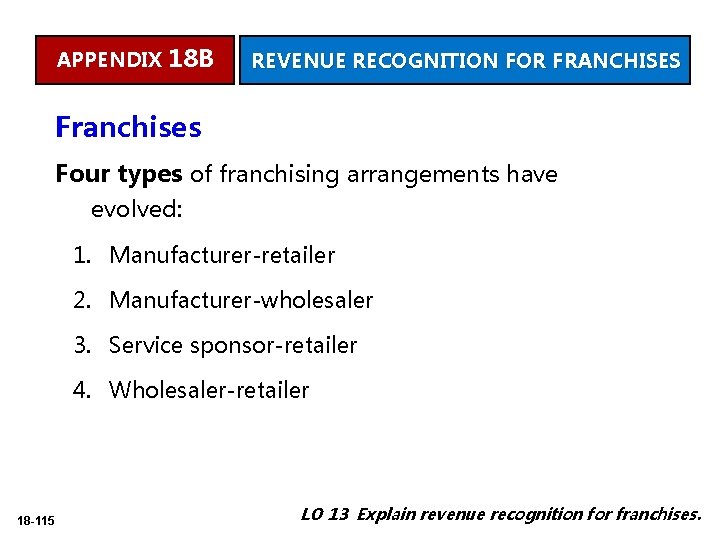
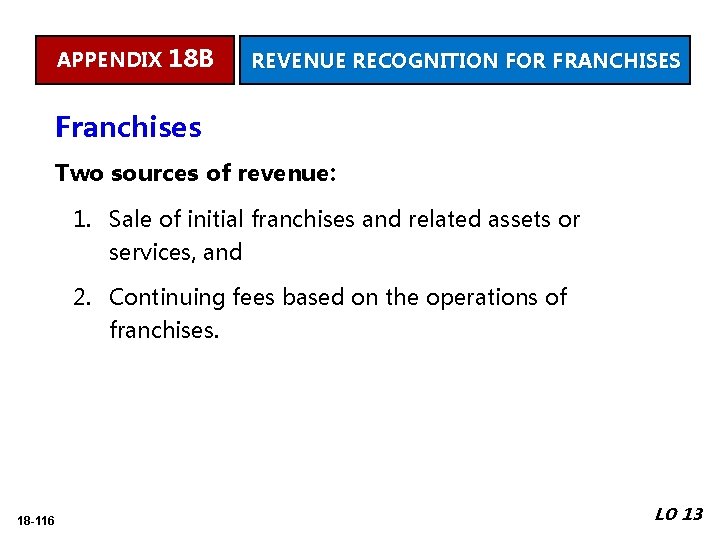
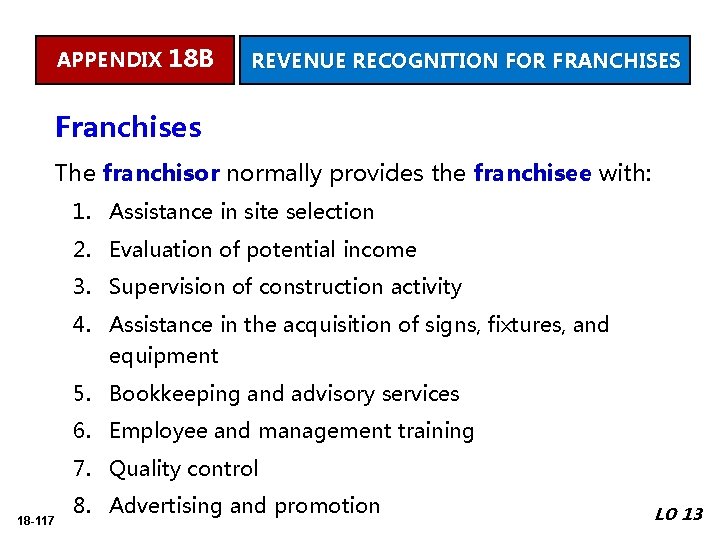
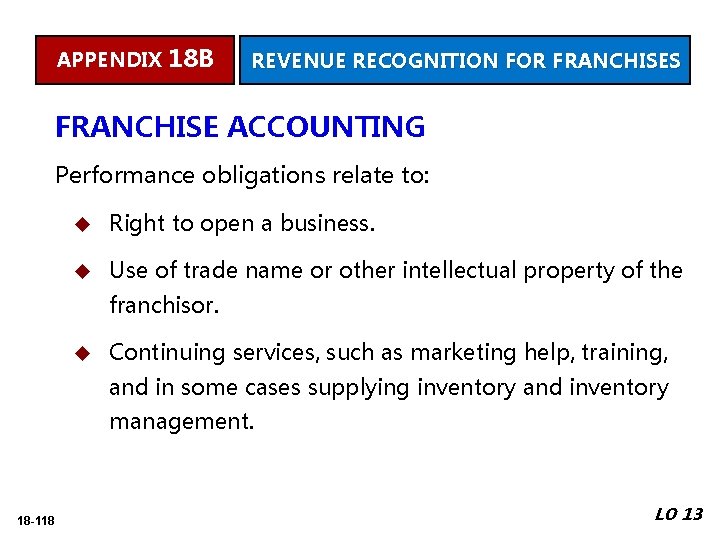
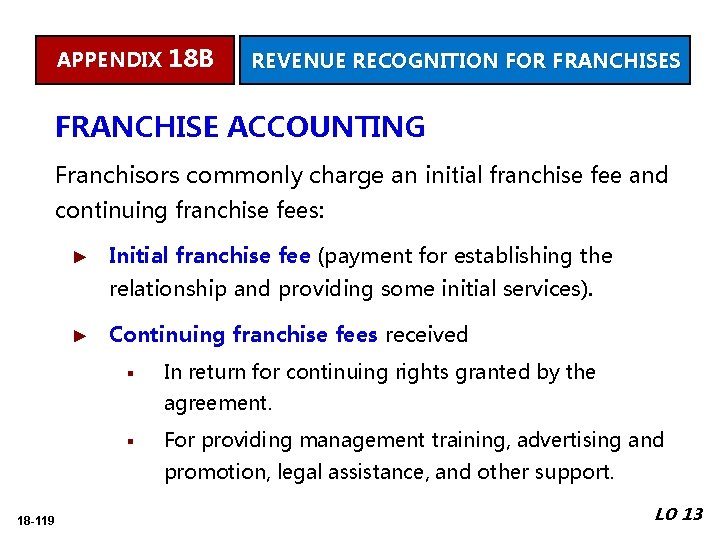
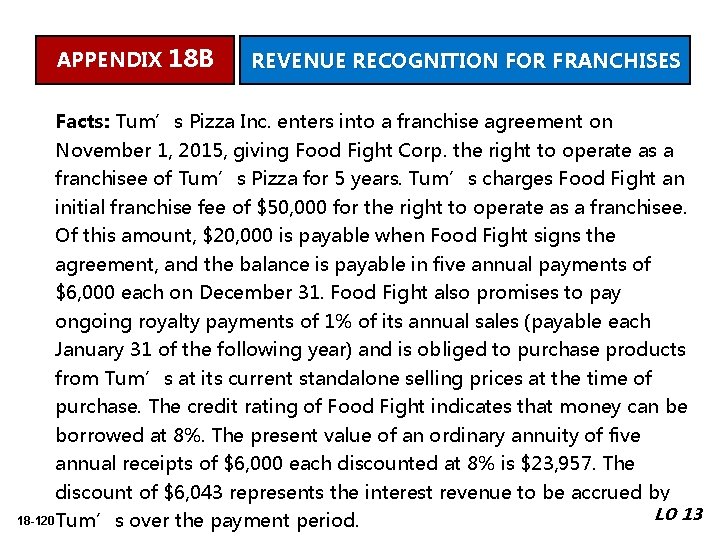
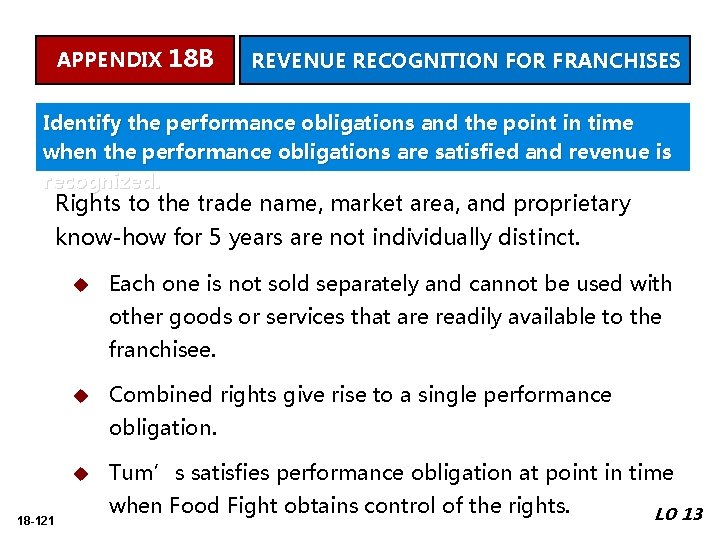
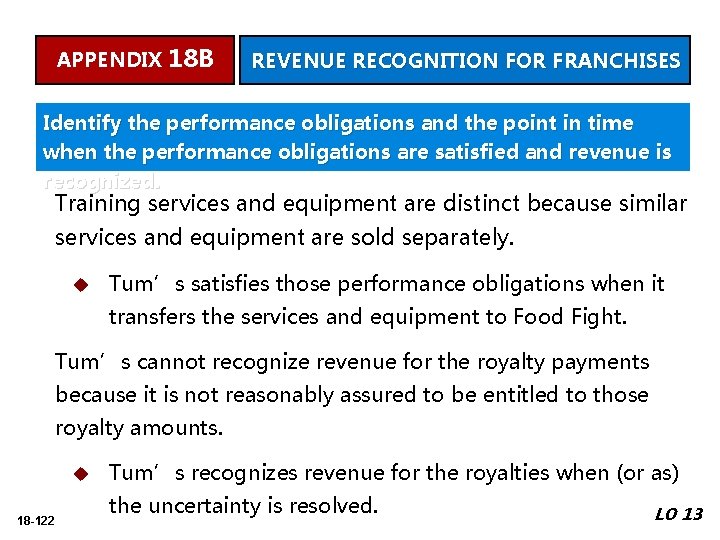
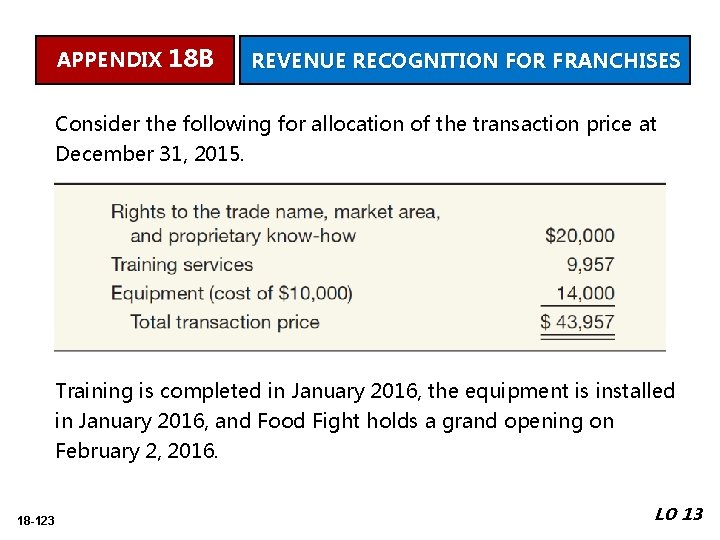
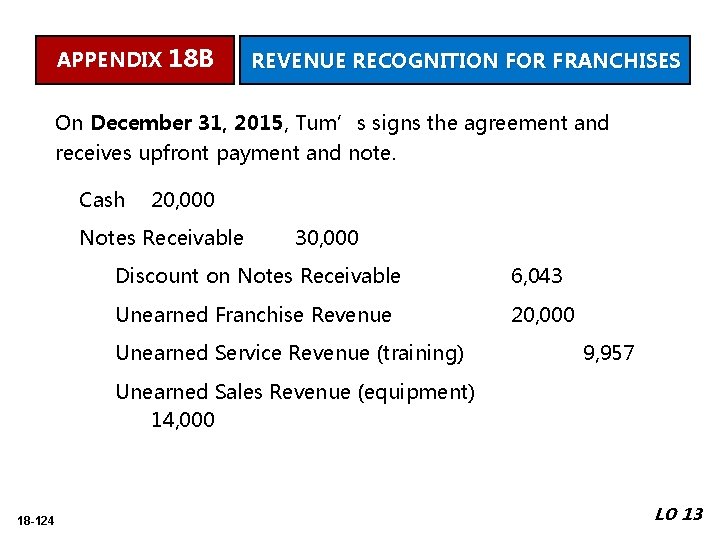
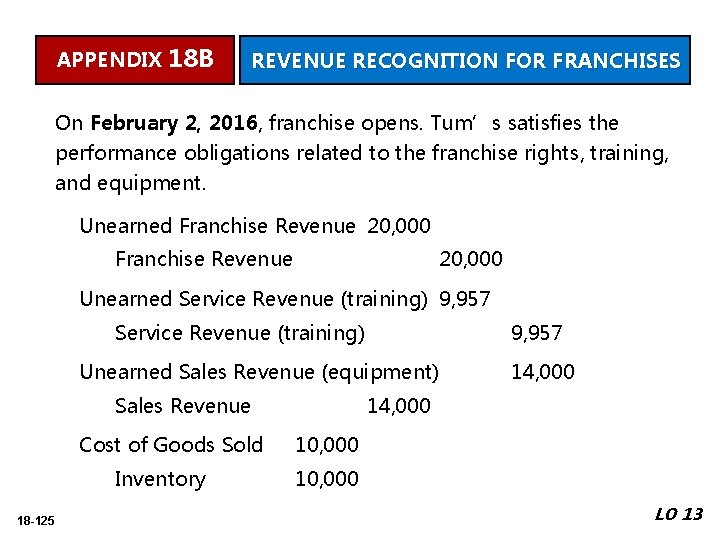
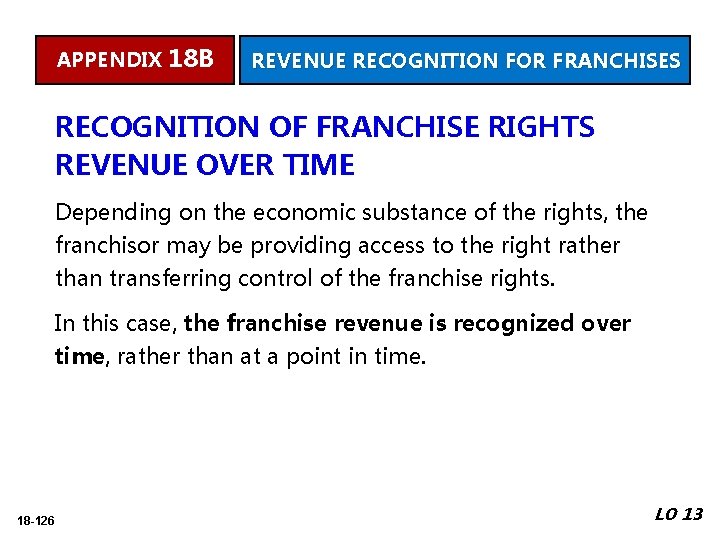
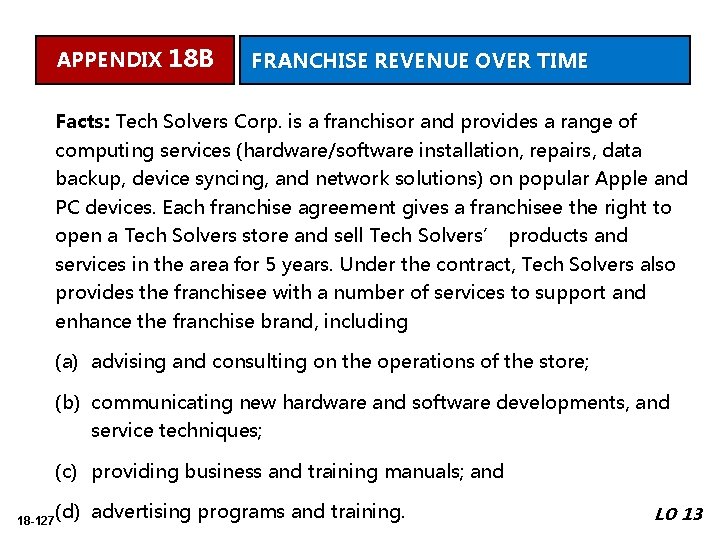
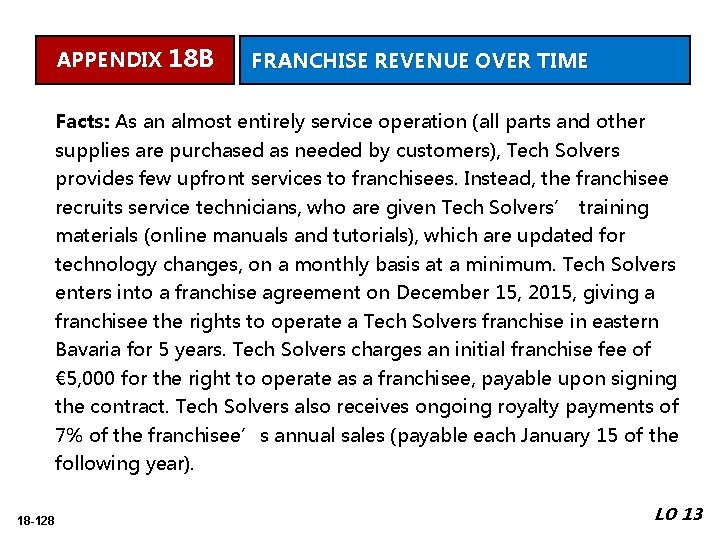
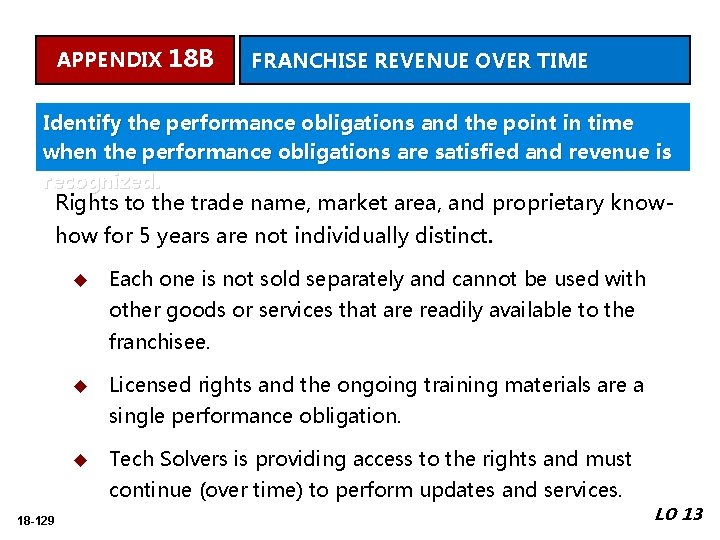
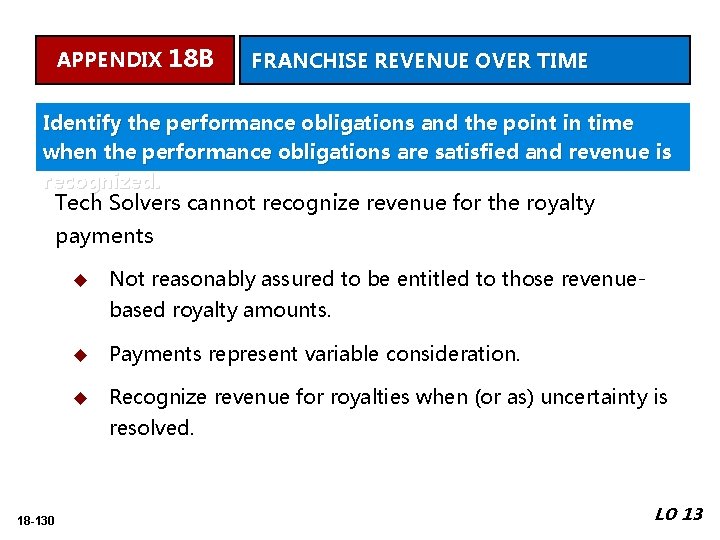
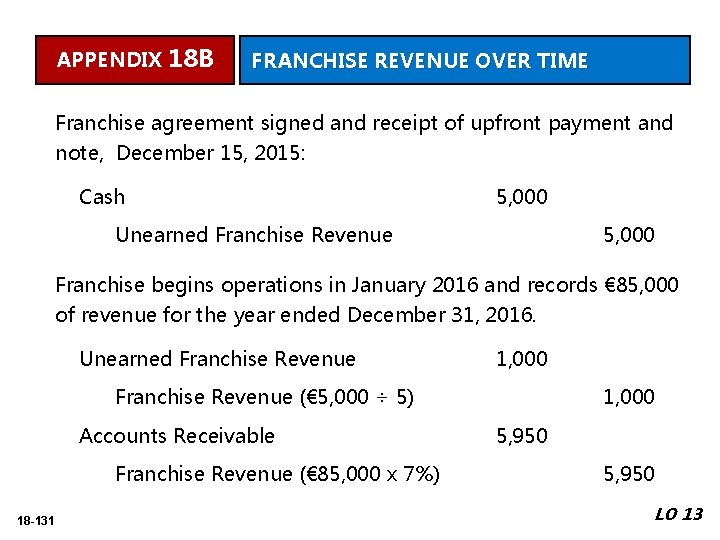
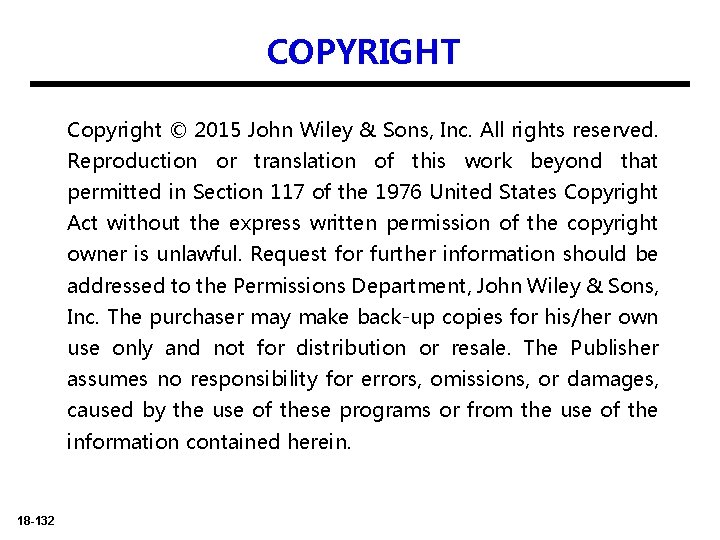
- Slides: 132

18 -1

PREVIEW OF CHAPTER 18 Intermediate Accounting IFRS 2 nd Edition Kieso, Weygandt, and Warfield 18 -2

18 Revenue Recognition LEARNING OBJECTIVES After studying this chapter, you should be able to: 6. Allocate the transaction price to the 1. Understand revenue recognition separate performance obligations. issues. 2. Identify the five steps in the revenue recognition process. 3. Identify the contract with customers. 4. Identify the separate performance obligations in the contract. 5. Determine the transaction price. 18 -3 7. Recognize revenue when the company satisfies its performance obligation. 8. Identify other revenue recognition issues. 9. Describe presentation and disclosure regarding revenue.

OVERVIEW OF REVENUE RECOGNITION Background Revenue recognition is a top fraud risk and regardless of the accounting rules followed (IFRS or U. S. GAAP), the risk or errors and inaccuracies in revenue reporting is significant. Recently, the IASB and FASB issued a converged standard on revenue recognition entitled Revenue from Contracts with Customers. 18 -4 LO 1

OVERVIEW OF REVENUE RECOGNITION New Revenue Recognition Standard Revenue from Contracts with Customers, adopts an asset-liability approach. Companies: u Account for revenue based on the asset or liability arising from contracts with customers. u Are required to analyze contracts with customers ► Contracts indicate terms and measurement of consideration. ► 18 -5 Without contracts, companies cannot know whether promises will be met. LO 1

New Revenue Recognition Standard ILLUSTRATION 18 -1 Key Concepts of Revenue Recognition 18 -6 Performance Obligation is Satisfied LO 1

18 Revenue Recognition LEARNING OBJECTIVES After studying this chapter, you should be able 1. to: Understand revenue recognition 6. Allocate the transaction price to the issues. 2. Identify the five steps in the revenue recognition process. 3. Identify the contract with customers. 4. Identify the separate performance obligations in the contract. 5. Determine the transaction price. 18 -7 separate performance obligations. 7. Recognize revenue when the company satisfies its performance obligation. 8. Identify other revenue recognition issues. 9. Describe presentation and disclosure regarding revenue.

THE FIVE-STEP PROCESS Assume that Airbus (FRA) Corporation signs a contract to sell airplanes to Cathay Pacific Airlines (HKG) for € 100 million. A contract is an Step 1: Identify the contract with customers. Step 2: Identify the separate performance obligations in the contract. 18 -8 ILLUSTRATION 18 -2 Five Steps of Revenuetwo agreement between Recognition parties that creates enforceable rights or obligations. In this case, Airbus has signed a contract to deliver airplanes to Cathay Pacific. Airbus has only one performance obligation— to deliver airplanes to Cathay Pacific. If Airbus also agreed to maintain the planes, a separate performance obligation is recorded for this promise. LO 2

THE FIVE-STEP PROCESS ILLUSTRATION 18 -2 Five Steps of Revenue Recognition Step 3: Determine the transaction price. Transaction price is the amount of consideration that a company expects to receive from a customer in exchange for transferring a good or service. In this case, the transaction price is straightforward—it is € 100 million. Step 4: Allocate the transaction price to the separate performance obligations. In this case, Airbus has only one performance obligation—to deliver airplanes to Cathay Pacific. 18 -9 LO 2

THE FIVE-STEP PROCESS ILLUSTRATION 18 -2 Five Steps of Revenue Recognition Step 5: Recognize revenue when each performance obligation is satisfied. 18 -10 Airbus recognizes revenue of € 100 million for the sale of the airplanes to Cathay Pacific when it satisfies its performance obligation—the delivery of the airplanes to Cathay Pacific. LO 2

18 Revenue Recognition LEARNING OBJECTIVES After studying this chapter, you should be able 1. to: Understand revenue recognition 6. Allocate the transaction price to the issues. 2. Identify the five steps in the revenue recognition process. 3. Identify the contract with customers. 4. Identify the separate performance obligations in the contract. 5. Determine the transaction price. 18 -11 separate performance obligations. 7. Recognize revenue when the company satisfies its performance obligation. 8. Identify other revenue recognition issues. 9. Describe presentation and disclosure regarding revenue.

Identify Contract with Customers— Step 1 Contract: u Agreement between two or more parties that creates enforceable rights or obligations. u Can be ► written, ► oral, or ► implied from customary business practice. Company applies the revenue guidance to a contract according to the following criteria in Illustration 18 -3. 18 -12 LO 3

Contract with Customers—Step 1 ILLUSTRATION 18 -3 Contract Criteria for Revenue Guidance Apply Revenue Guidance to Contracts If: Disregard Revenue Guidance to Contracts If: § The contract has commercial substance; § The contract is wholly unperformed, and § The parties to the contract have approved the contract and are committed to perform § Each party can their respective obligations; unilaterally terminate the contract without § The company can identify each party’s compensation. rights regarding the goods or services to be transferred; and § The company can identify the payment terms for the goods and services to be transferred. § It is probable that the company will collect the consideration to which it will be entitled. 18 -13 LO 3

Contract with Customers—Step 1 Basic Accounting u Revenue cannot be recognized until a contract exists. u Company obtains rights to receive consideration and assumes obligations to transfer goods or services. u Rights and performance obligations gives rise to an (net) asset or (net) liability. u Company does not recognize contract assets or liabilities until one or both parties to the contract perform. Contract asset = Rights received > Performance obligation Contract liability = Rights received < Performance 18 -14 obligation LO 3

Basic Accounting ILLUSTRATION 18 -4 Basic Revenue Transaction CONTRACTS AND RECOGNITION Facts: On March 1, 2015, Margo Company enters into a contract to transfer a product to Soon Yoon on July 31, 2015. The contract is structured such that Soon Yoon is required to pay the full contract price of HK$5, 000 on August 31, 2015. The cost of the goods transferred is HK$3, 000. Margo delivers the product to Soon Yoon on July 31, 2015. Question: What journal entries should Margo Company make in regards to this contract in 2015? The journal entry to record the sale and related cost of goods sold is as follows. July. Accounts 31, 2015 Receivable 5, 000 Sales Revenue Cost of Goods Sold Inventory 18 -15 5, 000 3, 000 LO 3

Basic Accounting ILLUSTRATION 18 -4 Basic Revenue Transaction CONTRACTS AND RECOGNITION Facts: On March 1, 2015, Margo Company enters into a contract to transfer a product to Soon Yoon on July 31, 2015. The contract is structured such that Soon Yoon is required to pay the full contract price of HK$5, 000 on August 31, 2015. The cost of the goods transferred is HK$3, 000. Margo delivers the product to Soon Yoon on July 31, 2015. Question: What journal entries should Margo Company make in regards to this contract in 2015? Margo makes the following entry to record the receipt of cash on August 31, 2015. August Cash 31, 2015 Accounts Receivable 18 -16 5, 000 LO 3

Contract with Customers—Step 1 Contract Modifications 18 -17 u Change in contract terms while it is ongoing. u Companies determine ► whether a new contract (and performance obligations) results or ► whether it is a modification of the existing contract. LO 3

Contract Modifications Separate Performance Obligation u Account for as a new contract if both of the following conditions are satisfied: ► Promised goods or services are distinct (i. e. , company sells them separately and they are not interdependent with other goods and services), and ► 18 -18 The company has the right to receive an amount of consideration that reflects the standalone selling price of the promised goods or services. LO 3

Separate Performance Obligation For example, Crandall Co. has a contract to sell 100 products to a customer for $10, 000 (€ 100 per product) at various points in time over a six-month period. After 60 products have been delivered, Crandall modifies the contract by promising to deliver 20 more products for an additional € 1, 900, or € 95 per product (which is the standalone selling price of the products at the time of the contract modification). Crandall regularly sells the products separately. Given a new contract, Crandall recognizes an additional: Original contract [(100 units - 60 units) x € 100] = € 4, 000 New product (20 units x € 95) = Total revenue 18 -19 1, 900 € 5, 900 LO 3

Contract Modifications Prospective Modification u 18 -20 Company should ► account for effect of change in period of change as well as future periods if change affects both. ► not change previously reported results. LO 3

Prospective Modification For Crandall, the amount recognized as revenue for each of the remaining products would be a blended price of € 98. 33, computed as shown in Illustration 18 -5. Products not delivered under original contract ($100 x € 40) = € 4, 000 Products to be delivered under contract modification (€ 95 x 20) = Total remaining revenue 1, 900 € 5, 900 Revenue per remaining unit (€ 5, 900 ÷ 60) = € 98. 33 18 -21 LO 3

Prospective Modification Under the prospective approach, a blended price (€ 98. 33) is used for sales in the periods after the modification. ILLUSTRATION 18 -6 Comparison of Contract Modification Approaches 18 -22 LO 3

18 Revenue Recognition LEARNING OBJECTIVES After studying this chapter, you should be able 1. to: Understand revenue recognition 6. Allocate the transaction price to the issues. 2. Identify the five steps in the revenue recognition process. 3. Identify the contract with customers. 4. Identify the separate performance obligations in the contract. 5. Determine the transaction price. 18 -23 separate performance obligations. 7. Recognize revenue when the company satisfies its performance obligation. 8. Identify other revenue recognition issues. 9. Describe presentation and disclosure regarding revenue.

Separate Performance Obligations— Step 2 Revenue Recognition Situations ILLUSTRATION 18 -7 Type of Transaction Sale of product from inventory Performing a service Permitting use of an asset Sale of asset other than inventory Description of Revenue from sales Revenue from fees or services Revenue from interest, rents, and royalties Gain or loss on disposition Timing of Revenue Recognition Date of sale (date of delivery) Services performed and billable As time passes or assets are used Date of sale or trade-in 18 -24 LO 4

Separate Performance Obligations— Step 2 u To determine whether a company has to account for multiple performance obligations, it evaluates a secondition. u 18 -25 Whether the product is distinct within the contract. ► If performance obligation is not highly dependent on, or interrelated with, other promises in the contract, then each performance obligation should be accounted for separately. ► If each of these services is interdependent and interrelated, these services are combined and reported as one performance obligation. LO 4

Performance Obligations—Step 2 ILLUSTRATION 18 -8 Identifying Performance Obligations Soft. Tech Inc. licenses customer-relationship software to Lopez Company. In addition to providing the software itself, Soft. Tech promises to provide consulting services by extensively customizing the software to Lopez’s information technology environment, for a total consideration of $600, 000. In this case, Soft. Tech is providing a significant service by integrating the goods and services (the license and the consulting service) into one combined item for which Lopez has contracted. In addition, the software is significantly customized by Soft. Tech in accordance with specifications negotiated by Lopez. Do these facts describe a single or separate performance obligation? The license and the consulting services are distinct but interdependent, and therefore should be accounted for as one performance obligation. 18 -26 LO 4

Performance Obligations—Step 2 ILLUSTRATION 18 -8 Identifying Performance Obligations Chen Computer Inc. manufactures and sells computers that include a warranty to make good on any defect in its computers for 120 days (often referred to as an assurance warranty). In addition, it sells separately an extended warranty, which provides protection from defects for three years beyond the 120 days (often referred to as a service warranty). In this case, two performance obligations exist, one related to the sale of the computer and the assurance warranty, and the other to the extended warranty (service warranty). The sale of the computer and related assurance warranty are one performance obligation as they are interdependent and interrelated with each other. However, the extended warranty is separately sold and is not interdependent. 18 -27 LO 4

18 Revenue Recognition LEARNING OBJECTIVES After studying this chapter, you should be able 1. to: Understand revenue recognition 6. Allocate the transaction price to the issues. 2. Identify the five steps in the revenue recognition process. 3. Identify the contract with customers. 4. Identify the separate performance obligations in the contract. 5. Determine the transaction price. 18 -28 separate performance obligations. 7. Recognize revenue when the company satisfies its performance obligation. 8. Identify other revenue recognition issues. 9. Describe presentation and disclosure regarding revenue.

Determining Transaction Price—Step 3 Transaction price 18 -29 u Amount of consideration that company expects to receive from a customer. u In a contract is often easily determined because customer agrees to pay a fixed amount. u Other contracts, companies must consider: ► Variable consideration ► Time value of money ► Non-cash consideration ► Consideration paid or payable to customers LO 5

Determining Transaction Price—Step 3 Variable Consideration u Price dependent on future events. ► u 18 -30 May include discounts, rebates, credits, performance bonuses, or royalties. Companies estimate amount of revenue to recognize. ► Expected value ► Most likely amount LO 5

Determining Transaction Price—Step 3 ILLUSTRATION 18 -9 Estimating Variable Consideration Expected Value: Probability-weighted amount in a range of possible consideration amounts. § May be appropriate if a company has a large number of contracts with similar characteristics. § Can be based on a limited number of discrete outcomes and probabilities. Most Likely Amount: The single most likely amount in a range of possible consideration outcomes. § May be appropriate if the contract has only two possible outcomes. 18 -31 LO 5

Variable Consideration ILLUSTRATION 18 -10 Transaction Price ESTIMATING VARIABLE CONSIDERATION Facts: Peabody Construction Company enters into a contract with a customer to build a warehouse for $100, 000, with a performance bonus of $50, 000 that will be paid based on the timing of completion. The amount of the performance bonus decreases by 10% per week for every week beyond the agreed-upon completion date. The contract requirements are similar to contracts that Peabody has performed previously, and management believes that such experience is predictive for this contract. Management estimates that there is a 60% probability that the contract will be completed by the agreed-upon completion date, a 30% probability that it will be completed 1 week late, and only a 10% probability that it will be completed 2 weeks late. Question: How should Peabody account for this revenue arrangement? 18 -32 LO 5

Variable Consideration ILLUSTRATION 18 -10 Transaction Price Question: How should Peabody account for this revenue arrangement? Management has concluded that the probability-weighted method is the most predictive approach: 60% chance of $150, 000 = 30% chance of $145, 000 = 10% chance of $140, 000 = $ 90, 000 43, 500 14, 000 $147, 500 Most likely outcome, if management believes they will meet the deadline and receive the $50, 000 bonus, the total transaction price would be? $150, 000 (the outcome with 60% probability) 18 -33 LO 5

Variable Consideration u Companies only allocate variable consideration if it is reasonably assured that it will be entitled to the amount. u Companies only recognize variable consideration if 1. they have experience with similar contracts and are able to estimate the cumulative amount of revenue, and 2. based on experience, they do not expect a significant reversal of revenue previously recognized. If these criteria are not met, revenue recognition is 18 -34 constrained. LO 5

Determining Transaction Price—Step 3 Time Value of Money u 18 -35 When contract (sales transaction) involves a significant financing component. ► Interest accrued on consideration to be paid over time. ► Fair value determined either by measuring the consideration received or by discounting the payment using an imputed interest rate. ► Company reports as interest expense or interest revenue. LO 5

ILLUSTRATION 18 -12 Transaction Price Extended Payment Terms Time Value of Money EXTENDED PAYMENT TERMS Facts: On July 1, 2015, SEK Company sold goods to Silva Company for R$900, 000 in exchange for a 4 -year, zero-interest-bearing note with a face amount of R$1, 416, 163. The goods have a cost on SEK’s books of R$590, 000. Questions: (a) How much revenue should SEK Company record on July 1, 2015? (b) How much revenue should it report related to this transaction on December 31, 2015? Entry to record SEK’s sale to Silva Company on July 1, 2015, is as follows. Notes Receivable Sales Revenue 900, 000 Discount on Notes Receivable 516, 163 Cost of Goods Sold Inventory 18 -36 1, 416, 163 590, 000 LO 5

ILLUSTRATION 18 -12 Transaction Price Extended Payment Terms Time Value of Money EXTENDED PAYMENT TERMS Facts: On July 1, 2015, SEK Company sold goods to Silva Company for R$900, 000 in exchange for a 4 -year, zero-interest-bearing note with a face amount of R$1, 416, 163. The goods have a cost on SEK’s books of R$590, 000. Questions: (a) How much revenue should SEK Company record on July 1, 2015? (b) How much revenue should it report related to this transaction on December 31, 2015? Entry to record interest revenue at the end of the year, December 31, 2015. Discount on Notes Receivable 54, 000 Interest Revenue (12% x ½ x $900, 000) 54, 000 Companies are not required to reflect the time value of money if the time period for payment is less than a year. 18 -37 LO 5

Determining Transaction Price—Step 3 Non-Cash Consideration Goods, services, or other non-cash consideration. u Companies sometimes receive contributions (e. g. , donations and gifts). u Customers sometimes contribute goods or services, such as equipment or labor, as consideration for goods provided or services performed. u 18 -38 Companies generally recognize revenue on the basis of the fair value of what is received. LO 5

Determining Transaction Price—Step 3 Consideration Paid or Payable to Customers 18 -39 u May include discounts, volume rebates, coupons, free products, or services. u In general, these elements reduce the consideration received and the revenue to be recognized. LO 5

ILLUSTRATION 18 -13 Transaction Price – Volume Discount Consideration Paid or Payable VOLUME DISCOUNT Facts: Sansung Company offers its customers a 3% volume discount if they purchase at least ¥ 2 million of its product during the calendar year. On March 31, 2015, Sansung has made sales of ¥ 700, 000 to Artic Co. In the previous 2 years, Sansung sold over ¥ 3, 000 to Artic in the period April 1 to December 31. Questions: How much revenue should Sansung recognize for the first 3 months of 2015? Sansung makes the following entry on March 31, 2015. Accounts Receivable Sales Revenue 679, 000 Sansung should reduce its revenue by ¥ 21, 000 (¥ 700, 000 x 3%) because it is probable that it will provide this rebate. 18 -40 LO 5

ILLUSTRATION 18 -13 Transaction Price – Volume Discount Consideration Paid or Payable Questions: How much revenue should Sansung recognize for the first 3 months of 2015? Assuming Sansung’s customer meets the discount threshold, Sansung makes the following entry. Cash 679, 000 Accounts Receivable 679, 000 If Sansung’s customer fails to meet the discount threshold, Sansung makes the following entry upon payment. Cash Accounts Receivable Sales Discounts Forfeited 18 -41 700, 000 679, 000 21, 000 LO 5

18 Revenue Recognition LEARNING OBJECTIVES After studying this chapter, you should be able 1. to: Understand revenue recognition 6. Allocate the transaction price to issues. the separate performance obligations. 2. Identify the five steps in the revenue recognition process. 3. Identify the contract with customers. 4. Identify the separate performance obligations in the contract. 5. Determine the transaction price. 18 -42 7. Recognize revenue when the company satisfies its performance obligation. 8. Identify other revenue recognition issues. 9. Describe presentation and disclosure regarding revenue.

Allocating Transaction Price to Separate Performance Obligations—Step 4 u Based on their relative fair values. u Best measure of fair value is what the company could sell the good or service for on a standalone basis. u If not available, companies should use their best estimate of what the good or service might sell for as a standalone unit. 18 -43 LO 6

Allocating Transaction Price to Separate Performance Obligations—Step 4 ILLUSTRATION 1814 Transaction Price Allocation 18 -44 LO 6

18 Revenue Recognition LEARNING OBJECTIVES After studying this chapter, you should be able 1. to: Understand revenue recognition 6. Allocate the transaction price to the issues. 2. Identify the five steps in the revenue recognition process. 3. Identify the contract with customers. 4. Identify the separate performance obligations in the contract. 5. Determine the transaction price. 18 -45 separate performance obligations. 7. Recognize revenue when the company satisfies its performance obligation. 8. Identify other revenue recognition issues. 9. Describe presentation and disclosure regarding revenue.

Recognizing Revenue When (or as) Each Performance Obligation Is Satisfied. Step 5 Company satisfies its performance obligation when the customer obtains control of the good or service. Change in Control Indicators 1. Company has a right to payment for asset. 2. Company has transferred legal title to asset. 3. Company has transferred physical possession of asset. 4. Customer has significant risks and rewards of ownership. 5. Customer has accepted the asset. 18 -46 LO 7

Recognizing Revenue When (or as) Each Performance Obligation Is Satisfied. Step 5 Recognizing revenue from a performance obligation over time u Measure progress toward completion ► Method for measuring progress should depict transfer of control from company to customer. ► Most common are cost-to-cost and units-ofdelivery methods. ► 18 -47 Objective of methods is to measure extent of progress in terms of costs, units, or value added. LO 7

Recognizing Revenue When (or as) Each Performance Obligation Is Satisfied. Step 5 Step in Process Description Implementation 1. Identify the contract with customers. A contract is an agreement that creates enforceable rights or obligations. A company applies the revenue guidance to contracts with customers and must determine if new performance obligations are created by a contract modification. ILLUSTRATION 18 -20 Summary of the Five-Step Revenue Recognition Process 18 -48 LO 7

Recognizing Revenue When (or as) Each Performance Obligation Is Satisfied. Step 5 Step in Process Description Implementation 2. Identify the separate performanc e obligations in the contract ILLUSTRATION 18 -20 Summary of the Five-Step Revenue Recognition Process 18 -49 A performance obligation is a promise in a contract to provide a product or service to a customer. A performance obligation exists if the customer can benefit from the good or service on its own or together with other readily available resources. A contract may be comprised of multiple performance obligations. Accounting is based on evaluation of whether the product or service is distinct within the contract. If each of the goods or services is distinct, but is interdependent and interrelated, these goods and services are combined and reported as one performance obligation. LO 7

Recognizing Revenue When (or as) Each Performance Obligation Is Satisfied. Step 5 Step in Process Description Implementation 3. Determine the transaction price. Transaction price is the amount of consideration that a company expects to receive from a customer in exchange for transferring goods and services. In determining the transaction price, companies must consider the following factors: 1. variable consideration, 2. time value of money, 3. Non-cash consideration, and 4. consideration paid or payable to customer. ILLUSTRATION 18 -20 Summary of the Five-Step Revenue Recognition Process 18 -50 LO 7

Recognizing Revenue When (or as) Each Performance Obligation Is Satisfied. Step 5 Step in Process Description Implementation 4. Allocate the transaction price to the separate performanc e obligation. ILLUSTRATION 18 -20 Summary of the Five-Step Revenue Recognition Process 18 -51 If more than one performance obligation exists, allocate the transaction price based on relative fair values. The best measure of fair value is what the good service could be sold for on a standalone basis (standalone selling price). Estimates of standalone selling price can be based on 1. adjusted market assessment, 2. expected cost-plus a margin approach, or 3. a residual approach. LO 7

Recognizing Revenue When (or as) Each Performance Obligation Is Satisfied. Step 5 Step in Process Description Implementation 5. Recognize revenue when each performanc e obligation is satisfied. ILLUSTRATION 18 -20 Summary of the Five-Step Revenue Recognition Process 18 -52 A company satisfies its performance obligation when the customer obtains control of the good or service. Companies satisfy performance obligations either at a point in time or over a period of time. Companies recognize revenue over a period of time if 1. the customer controls the asset as it is created or 2. the company does not have an alternative use for the asset. LO 7

18 Revenue Recognition LEARNING OBJECTIVES After studying this chapter, you should be able 1. to: Understand revenue recognition 6. Allocate the transaction price to the issues. 2. Identify the five steps in the revenue recognition process. 3. Identify the contract with customers. separate performance obligations. 7. Recognize revenue when the company satisfies its performance obligation. 4. Identify the separate performance obligations in the contract. 8. Identify other revenue recognition issues. 5. Determine the transaction price. 9. Describe presentation and disclosure regarding revenue. 18 -53

OTHER REVENUE RECOGNITION ISSUES 18 -54 u Right of return u Consignments u Repurchase agreements u Warranties u Bill and hold u Non-refundable upfront fees u Principal-agent relationships LO 8

Right of Return u Right of return is granted for product for various reasons (e. g. , dissatisfaction with product). u Company returning the product receives any combination of the following. 1. Full or partial refund of any consideration paid. 2. Credit that can be applied against amounts owed, or that will be owed, to the seller. 3. Another product in exchange. 18 -55 LO 8

Right of Return ILLUSTRATION 18 -21 Recognition—Right of Return RIGHT OF RETURN Facts: Venden Company sells 100 products for € 100 each to Amaya Inc. for cash. Venden allows Amaya to return any unused product within 30 days and receive a full refund. The cost of each product is € 60. To determine the transaction price, Venden decides that the approach that is most predictive of the amount of consideration to which it will be entitled is the most likely amount. Using the most likely amount, Venden estimates that: 1. Three products will be returned. 2. The costs of recovering the products will be immaterial. 3. The returned products are expected to be resold at a profit. Question: How should Venden record this sale? 18 -56 LO 8

Right of Return ILLUSTRATION 18 -21 Recognition—Right of Return Question: How should Venden record this sale? Venden records the sale as follows with the expectation that three products will be returned: Cash 10, 000 Sales Revenue [€ 9, 700 x (€ 100 x 97)] 9, 700 Refund Liability (€ 100 x 3) 300 Venden records the cost of goods sold with the following entry. Cost of Goods Sold Estimated Inventory Returns (€ 60 x 3) Inventory 18 -57 5, 820 180 6, 000 LO 8

Right of Return ILLUSTRATION 18 -21 Recognition—Right of Return Question: How should Venden record this sale? When a return occurs, Venden records the following entries. Refund Liability (2 x € 100) 200 Accounts Payable Returned Inventory (2 x € 60) Estimated Inventory Returns 200 120 Companies record the returned asset in a separate account from inventory to provide transparency. 18 -58 LO 8

Repurchase Agreements u Transfer control of (sell) an asset to a customer but have an obligation or right to repurchase. u 18 -59 If obligation or right to repurchase is for an amount greater than or equal to selling price, then transaction is a financing transaction. LO 8

Repurchase Agreements ILLUSTRATION 18 -22 Recognition— Repurchase Agreement REPURCHASE AGREEMENT Facts: Morgan Inc. , an equipment dealer, sells equipment on January 1, 2015, to Lane Company for £ 100, 000. It agrees to repurchase this equipment on December 31, 2016, for a price of £ 121, 000. Question: How should Morgan Inc. record this transaction? Assuming an interest rate of 10 percent is imputed from the agreement, Morgan makes the following entry to record the financing on January 1, 2015. Cash 100, 000 Liability to Lane Company 18 -60 100, 000 LO 8

ILLUSTRATION 18 -22 Recognition— Repurchase Agreements Question: How should Morgan Inc. record this transaction? Morgan Inc. records interest on December 31, 2016, as follows. Interest Expense 10, 000 Liability to Lane Company (£ 100, 000 x 10%) 10, 000 Morgan Inc. records interest and retirement of its liability to Lane Company on December 31, 2016, as follows. Interest Expense 11, 000 Liability to Lane Company (£ 110, 000 x 10%) Liability to Lane Company Cash (£ 100, 000 + £ 11, 000) 18 -61 11, 000 121, 000 LO 8

18 -62 LO 8

Bill-and-Hold Arrangements u Contract under which an entity bills a customer for a product but the entity retains physical possession of the product until a point in time in the future. u 18 -63 Result when buyer is not yet ready to take delivery but does take title and accepts billing. LO 8

Bill-and-Hold Arrangements ILLUSTRATION 18 -23 Recognition—Bill and Hold BILL AND HOLD Facts: Kaya Company sells ₺ 450, 000 (cost ₺ 280, 000) of fireplaces on March 1, 2015, to a local coffee shop, Baristo, which is planning to expand its locations around the city. Under the agreement, Baristo asks Kaya to retain these fireplaces in its warehouses until the new coffee shops that will house the fireplaces are ready. Title passes to Baristo at the time the agreement is signed. Question: When should Kaya recognize the revenue from this bill-and-hold arrangement? Kaya determines when it has satisfied its performance obligation to transfer a product by evaluating when Baristo obtains control of that product. 18 -64 LO 8

Bill-and-Hold Arrangements ILLUSTRATION 18 -23 Recognition—Bill and Hold Question: When should Kaya recognize the revenue from this bill-and-hold arrangement? For Baristo to have obtained control of a product in a bill-and-hold arrangement, all of the following criteria should be met: (a) The reason for the bill-and-hold arrangement must be substantive. (b) The product must be identified separately as belonging to Baristo. (c) The product currently must be ready for physical transfer to Baristo. (d) Kaya cannot have the ability to use the product or to direct it to another customer. In this case, it appears that the above criteria were met, and therefore revenue recognition should be permitted at the time the contract is signed. 18 -65 LO 8

Bill-and-Hold Arrangements ILLUSTRATION 18 -23 Recognition—Bill and Hold Question: When should Kaya recognize the revenue from this bill-and-hold arrangement? Kaya makes the following entry to record the sale. Accounts receivable 450, 000 Sales Revenue 450, 000 Kaya makes an entry to record the related cost of goods sold as follows. Cost of Goods Sold Inventory 18 -66 280, 000 LO 8

Principal-Agent Relationships u Agent’s performance obligation is to arrange for principal to provide goods or services to a customer. u Examples: u ► Preferred Travel Company (agent) facilitates the booking of cruise excursions by finding customers for Regency Cruise Company (principal). ► Priceline (USA) (agent) facilitates the sale of various services such as car rentals at Hertz (USA) (principal). Amounts collected on behalf of the principal are not revenue of the agent. ► 18 -67 Revenue for agent is amount of commission received. LO 8

18 -68 LO 8

Consignments u Manufacturers (or wholesalers) deliver goods but retain title to the goods until they are sold. u Consignor (manufacturer or wholesaler) ships merchandise to the consignee (dealer), who is to act as an agent for the consignor in selling the merchandise. u Consignor makes a profit on the sale. ► u 18 -69 Carries merchandise as inventory. Consignee makes a commission on the sale. LO 8

Consignments 18 -70 ILLUSTRATION 18 -25 Recognition—Sales on Consignment LO 8

Consignments 18 -71 ILLUSTRATION 18 -25 Recognition—Sales on Consignment LO 8

Warranties Two types of warranties to customers: 1. Product meets agreed-upon specifications in contract at time product is sold. a. Warranty is included in sales price (assurancetype warranty). 2. Not included in sales price of product (service-type warranty). a. Recorded as a separate performance obligation. 18 -72 LO 8

Warranties ILLUSTRATION 18 -26 Performance Obligations and Warranties WARRANTIES Facts: Maverick Company sold 1, 000 Rollomatics during 2015 at a total price of $6, 000, with a warranty guarantee that the product was free of any defects. The cost of Rollomatics sold is $4, 000. The term of the assurance warranty is two years, with an estimated cost of $30, 000. In addition, Maverick sold extended warranties related to 400 Rollomatics for 3 years beyond the 2 -year period for $12, 000. Question: What are the journal entries that Maverick Company should make in 2015 related to the sale and the related warranties? 18 -73 LO 8

ILLUSTRATION 18 -26 Performance Obligations and Warranties Question: What are the journal entries that Maverick Company should make in 2015 related to the sale and the related warranties? To record the revenue and liabilities related to the warranties: Cash ($6, 000 + $12, 000) Warranty Expense 6, 012, 000 30, 000 Warranty Liability 30, 000 Unearned Warranty Revenue 12, 000 Sales Revenue 6, 000 To reduce inventory and recognize cost of goods sold: Cost of Goods Sold Inventory 18 -74 4, 000, 000 LO 8

Non-Refundable Upfront Fees u Payments from customers before ► Delivery of a product. ► Performance of a service. u Generally relate to initiation, activation, or setup of a good or service to be provided or performed in the future. u Most cases, upfront payments are nonrefundable. ► 18 -75 Examples include: § Membership fee in a health club. § Activation fees for phone, Internet, or cable. LO 8

18 Revenue Recognition LEARNING OBJECTIVES After studying this chapter, you should be able 1. to: Understand revenue recognition 6. Allocate the transaction price to the issues. 2. Identify the five steps in the revenue recognition process. 3. Identify the contract with customers. 4. Identify the separate performance obligations in the contract. 5. Determine the transaction price. 18 -76 separate performance obligations. 7. Recognize revenue when the company satisfies its performance obligation. 8. Identify other revenue recognition issues. 9. Describe presentation and disclosure regarding revenue.

PRESENTATION AND DISCLOSURE Presentation Contract Assets and Liabilities u Contract assets are of two types: 1. Unconditional rights to receive consideration because company has satisfied its performance obligation. 18 -77 2. Conditional rights to receive consideration because company has satisfied one performance obligation but must satisfy another performance obligation before it can bill the customer. LO 9

Presentation ILLUSTRATION 18 -29 Contract Asset Recognition and Presentation CONTRACT ASSET Facts: On January 1, 2015, Finn Company enters into a contract to transfer Product A and Product B to Obermine Co. for € 100, 000. The contract specifies that payment of Product A will not occur until Product B is also delivered. In other words, payment will not occur until both Product A and Product B are transferred to Obermine. Finn determines that standalone prices are € 30, 000 for Product A and € 70, 000 for Product B. Finn delivers Product A to Obermine on February 1, 2015. On March 1, 2015, Finn delivers Product B to Obermine. Question: What journal entries should Finn Company make in regards to this contract in 2015? 18 -78 LO 9

ILLUSTRATION 18 -29 Contract Asset Recognition and Presentation Question: What journal entries should Finn Company make in regards to this contract in 2015? On February 1, 2015, Finn records the following entry: Contract Asset 30, 000 Sales Revenue 30, 000 On February 1, Finn does not record an accounts receivable because it does not have an unconditional right to receive the € 100, 000 unless it also transfers Product B to Obermine. When Finn transfers Product B on March 1, 2015, it makes the following entry. Accounts Receivable Contract Asset Sales Revenue 18 -79 100, 000 30, 000 70, 000 LO 9

Presentation ILLUSTRATION 18 -30 Contract Liability Recognition and Presentation CONTRACT LIABILITY Facts: On March 1, 2015, Henly Company enters into a contract to transfer a product to Propel Inc. on July 31, 2015. It is agreed that Propel will pay the full price of $10, 000 in advance on April 1, 2015. The contract is non-cancelable. Propel, however, does not pay until April 15, 2015, and Henly delivers the product on July 31, 2015. The cost of the product is $7, 500. Question: What journal entries are required in 2015? No entry is required on March 1, 2015: 18 -80 ► Neither party has performed on the contract. ► Neither party has an unconditional right as of March 1, 2015. LO 9

Presentation ILLUSTRATION 18 -30 Contract Liability Recognition and Presentation Question: What journal entries are required in 2015? On receiving the cash on April 15, 2015, Henly records the following entry. Cash 10, 000 Unearned Sales Revenue 10, 000 On satisfying the performance obligation on July 31, 2015, Henly records the following entry to record the sale. Unearned Sales Revenue 10, 000 In addition, Henly records cost of goods sold as follows. Cost of Good Sold Inventory 18 -81 7, 500 LO 9

Presentation Costs to Fulfill a Contract u Companies divide fulfillment costs (contract acquisition costs) into two categories: 1. Those that give rise to an asset. 2. Those that are expensed as incurred. 18 -82 LO 9

Presentation Collectibility u 18 -83 Credit risk that a customer will be unable to pay in accordance with the contract. ► Whether a company will get paid is not a consideration in determining revenue recognition. ► Amount recognized as revenue is not adjusted for customer credit risk. LO 9

Disclosure Companies disclose qualitative and quantitative information about the following: 18 -84 u Contracts with customers. u Significant judgments. u Assets recognized from costs incurred to fulfill a contract. LO 9

Disclosure Companies provide a range of disclosures: 18 -85 u Disaggregation of revenue. u Reconciliation of contract balances. u Remaining performance obligations. u Cost to obtain or fulfill contracts. u Other qualitative disclosures. ► Significant judgments and changes in them. ► Minimum revenue not subject to variable consideration constraint. LO 9

APPENDIX 18 A LONG-TERM CONSTRUCTION CONTRACTS REVENUE RECOGNITION OVER TIME Under certain circumstances companies recognize revenue over time. The most notable context in which revenue may be recognized over time is long-term construction contract accounting. 18 -86 LO 10 Apply the percentage-of-completion method for long-term contracts.

APPENDIX 18 A LONG-TERM CONSTRUCTION CONTRACTS REVENUE RECOGNITION OVER TIME Long-term contracts frequently provide that seller (builder) may bill purchaser at intervals. ► 18 -87 Examples: § Development of military and commercial aircraft § Weapons-delivery systems § Space exploration hardware LO 10

APPENDIX 18 A LONG-TERM CONSTRUCTION CONTRACTS REVENUE RECOGNITION OVER TIME A company recognizes revenue over time if at least one of the following two criteria is met: 1. Company’s performance creates or enhances an asset (e. g. , work in process) that the customer controls as the asset is created or enhanced; or 2. Company’s performance does not create an asset with an alternative use. In addition… 18 -88 LO 10

APPENDIX 18 A LONG-TERM CONSTRUCTION CONTRACTS REVENUE RECOGNITION OVER TIME In addition at least one of the following criteria must be met: a. The customer simultaneously receives and consumes the benefits of the entity’s performance as the entity performs. b. Another company would not need to substantially reperform the work the company has completed to date if that other company were to fulfill the remaining obligation to the customer. 18 -89 c. The company has a right to payment for its performance completed to date, and it expects to fulfill the contract as. LO 10

APPENDIX 18 A LONG-TERM CONSTRUCTION CONTRACTS REVENUE RECOGNITION OVER TIME If criterion 1 or 2 is met, then a company recognizes revenue over time if it can reasonably estimate its progress toward satisfaction of the performance obligations. 18 -90 u Company recognizes revenues and gross profits each period based upon the progress of the construction— referred to as the percentage-of-completion method. u If criteria are not met, the company recognizes revenues and gross profit when the contract is completed, referred to as the cost-recovery (zero- LO 10

APPENDIX 18 A LONG-TERM CONSTRUCTION CONTRACTS Percentage-of-Completion Method Measuring the Progress Toward Completion Most popular input measure used to determine the progress toward completion is the cost-to-cost basis. 18 -91 LO 10

APPENDIX 18 A LONG-TERM CONSTRUCTION CONTRACTS Percentage-of-Completion Method Revenue to Recognized Cost-to-Cost Basis ILLUSTRATION 18 A-1 ILLUSTRATION 18 A-2 ILLUSTRATION 18 A-3 18 -92 LO 10

APPENDIX 18 A PERCENTAGE-OF-COMPLETION METHOD Illustration: Hardhat Construction Company has a contract to construct a £ 4, 500, 000 bridge at an estimated cost of £ 4, 000. The contract is to start in July 2015, and the bridge is to be completed in October 2017. The following data pertain to the construction period. 18 -93 LO 10

APPENDIX 18 A PERCENTAGE-OF-COMPLETION METHOD ILLUSTRATION 18 A-4 18 -94 LO 10

APPENDIX 18 A PERCENTAGE-OF-COMPLETION METHOD ILLUSTRATION 18 A-5 18 -95 LO 10

APPENDIX 18 A PERCENTAGE-OF-COMPLETION METHOD Illustration: Percentage-of-Completion Revenue, Costs, and Gross Profit by Year 18 -96 ILLUSTRATION 18 A-6 LO 10

ILLUSTRATION 18 A-6 APPENDIX 18 A PERCENTAGE-OFCOMPLETION METHOD ILLUSTRATION 18 A-7 18 -97 LO 10

APPENDIX 18 A PERCENTAGE-OF-COMPLETION METHOD Illustration: Content of Construction in Process Account— Percentage-of-Completion Method ILLUSTRATION 18 A-8 18 -98 LO 10

APPENDIX 18 A PERCENTAGE-OF-COMPLETION METHOD Financial Statement Presentation— Percentage-of-Completion Computation of Unbilled Contract Price at 12/31/15 ILLUSTRATION 18 A-9 18 -99 LO 10

APPENDIX 18 A PERCENTAGE-OF-COMPLETION METHOD Financial Statement Presentation— Percentage-of-Completion Method (2015) ILLUSTRATION 18 A-10 18 -100 LO 10

APPENDIX 18 A PERCENTAGE-OF-COMPLETION METHOD Financial Statement Presentation— Percentage-of-Completion Method (2016) ILLUSTRATION 18 A-11 18 -101 LO 10

APPENDIX 18 A LONG-TERM CONSTRUCTION CONTRACTS Cost-Recovery (Zero-Profit) Method This method recognizes revenue only to the extent of costs incurred that are expected to be recoverable. Only after all costs are incurred is gross profit recognized. 18 -102 LO 11 Apply the cost-recovery method for long-term contracts.

APPENDIX 18 A COST-RECOVERY (ZERO-PROFIT) METHOD Illustration: Hardhat Construction would report the following revenues and costs for 2015– 2017. 18 -103 ILLUSTRATION 18 A-14 LO 11

APPENDIX 18 A COST-RECOVERY (ZERO-PROFIT) METHOD ILLUSTRATION 18 A-14 Cost-Recovery Method Revenue, Costs, and Gross Profit by Year ILLUSTRATION 18 A-15 Journal Entries— Cost-Recovery Method 18 -104 LO 11

APPENDIX 18 A COST-RECOVERY (ZERO-PROFIT) METHOD ILLUSTRATION 18 A 14 Cost-Recovery Method Revenue, Costs, and Gross Profit by Year ILLUSTRATION 18 A 16 Comparison of Gross Profit Recognized under Different Methods 18 -105 LO 11

APPENDIX 18 -106 18 A COST-RECOVERY (ZERO-PROFIT) METHOD ILLUSTRATION 18 A-17 Financial Statement Presentation—Cost- Recovery Method LO 11

APPENDIX 18 A LONG-TERM CONSTRUCTION CONTRACTS Long-Term Contract Losses 1. Loss in Current Period on a Profitable Contract ► Percentage-of-completion method only, the estimated cost increase requires a current-period adjustment of gross profit recognized in prior periods. 2. Loss on an Unprofitable Contract ► 18 -107 Under both percentage-of-completion and costrecovery methods, the company must recognize in the current period the entire expected contract loss. LO 12 Identify the proper accounting for losses on long-term contracts.

APPENDIX 18 A LONG-TERM CONTRACT LOSSES Illustration: Loss in Current Period Casper Construction Co. Prepare the journal entries to record revenue and expense for 2014, 2015, and 2016 assuming the estimated cost to complete at the end of 2015 was $215, 436. 18 -108 Advance slide in presentation mode to reveal answers. LO 12

APPENDIX 18 A LONG-TERM CONTRACT LOSSES Illustration: Loss in Current Period 18 -109 LO 12

APPENDIX 18 A LONG-TERM CONTRACT LOSSES Illustration: Loss in Current Period 18 -110 LO 12

APPENDIX 18 A LONG-TERM CONTRACT LOSSES Illustration: Loss on Unprofitable Contract Casper Construction Co. Prepare the journal entries for 2014, 2015, and 2016 assuming the estimated cost to complete at the end of 2015 was $246, 038 instead of $170, 100. 18 -111 LO 12

APPENDIX 18 A LONG-TERM CONTRACT LOSSES Illustration: Loss on Unprofitable Contract 18 -112 $675, 000 – 683, 438 = (8, 438) cumulative loss LO 12

APPENDIX 18 A LONG-TERM CONTRACT LOSSES Illustration: Loss on Unprofitable Contract 18 -113 LO 12

APPENDIX 18 A LONG-TERM CONTRACT LOSSES Illustration: Loss on Unprofitable Contract For the Cost-Recovery method, companies would recognize the following loss : 18 -114 LO 12

APPENDIX 18 B REVENUE RECOGNITION FOR FRANCHISES Franchises Four types of franchising arrangements have evolved: 1. Manufacturer-retailer 2. Manufacturer-wholesaler 3. Service sponsor-retailer 4. Wholesaler-retailer 18 -115 LO 13 Explain revenue recognition for franchises.

APPENDIX 18 B REVENUE RECOGNITION FOR FRANCHISES Franchises Two sources of revenue: 1. Sale of initial franchises and related assets or services, and 2. Continuing fees based on the operations of franchises. 18 -116 LO 13

APPENDIX 18 B REVENUE RECOGNITION FOR FRANCHISES Franchises The franchisor normally provides the franchisee with: 1. Assistance in site selection 2. Evaluation of potential income 3. Supervision of construction activity 4. Assistance in the acquisition of signs, fixtures, and equipment 5. Bookkeeping and advisory services 6. Employee and management training 7. Quality control 18 -117 8. Advertising and promotion LO 13

APPENDIX 18 B REVENUE RECOGNITION FOR FRANCHISES FRANCHISE ACCOUNTING Performance obligations relate to: u Right to open a business. u Use of trade name or other intellectual property of the franchisor. u Continuing services, such as marketing help, training, and in some cases supplying inventory and inventory management. 18 -118 LO 13

APPENDIX 18 B REVENUE RECOGNITION FOR FRANCHISES FRANCHISE ACCOUNTING Franchisors commonly charge an initial franchise fee and continuing franchise fees: ► Initial franchise fee (payment for establishing the relationship and providing some initial services). ► Continuing franchise fees received § In return for continuing rights granted by the agreement. § For providing management training, advertising and promotion, legal assistance, and other support. 18 -119 LO 13

APPENDIX 18 B REVENUE RECOGNITION FOR FRANCHISES Facts: Tum’s Pizza Inc. enters into a franchise agreement on November 1, 2015, giving Food Fight Corp. the right to operate as a franchisee of Tum’s Pizza for 5 years. Tum’s charges Food Fight an initial franchise fee of $50, 000 for the right to operate as a franchisee. Of this amount, $20, 000 is payable when Food Fight signs the agreement, and the balance is payable in five annual payments of $6, 000 each on December 31. Food Fight also promises to pay ongoing royalty payments of 1% of its annual sales (payable each January 31 of the following year) and is obliged to purchase products from Tum’s at its current standalone selling prices at the time of purchase. The credit rating of Food Fight indicates that money can be borrowed at 8%. The present value of an ordinary annuity of five annual receipts of $6, 000 each discounted at 8% is $23, 957. The discount of $6, 043 represents the interest revenue to be accrued by LO 13 18 -120 Tum’s over the payment period.

APPENDIX 18 B REVENUE RECOGNITION FOR FRANCHISES Identify the performance obligations and the point in time when the performance obligations are satisfied and revenue is recognized. Rights to the trade name, market area, and proprietary know-how for 5 years are not individually distinct. u Each one is not sold separately and cannot be used with other goods or services that are readily available to the franchisee. u Combined rights give rise to a single performance obligation. u 18 -121 Tum’s satisfies performance obligation at point in time when Food Fight obtains control of the rights. LO 13

APPENDIX 18 B REVENUE RECOGNITION FOR FRANCHISES Identify the performance obligations and the point in time when the performance obligations are satisfied and revenue is recognized. Training services and equipment are distinct because similar services and equipment are sold separately. u Tum’s satisfies those performance obligations when it transfers the services and equipment to Food Fight. Tum’s cannot recognize revenue for the royalty payments because it is not reasonably assured to be entitled to those royalty amounts. u 18 -122 Tum’s recognizes revenue for the royalties when (or as) the uncertainty is resolved. LO 13

APPENDIX 18 B REVENUE RECOGNITION FOR FRANCHISES Consider the following for allocation of the transaction price at December 31, 2015. Training is completed in January 2016, the equipment is installed in January 2016, and Food Fight holds a grand opening on February 2, 2016. 18 -123 LO 13

APPENDIX 18 B REVENUE RECOGNITION FOR FRANCHISES On December 31, 2015, Tum’s signs the agreement and receives upfront payment and note. Cash 20, 000 Notes Receivable 30, 000 Discount on Notes Receivable 6, 043 Unearned Franchise Revenue 20, 000 Unearned Service Revenue (training) 9, 957 Unearned Sales Revenue (equipment) 14, 000 18 -124 LO 13

APPENDIX 18 B REVENUE RECOGNITION FOR FRANCHISES On February 2, 2016, franchise opens. Tum’s satisfies the performance obligations related to the franchise rights, training, and equipment. Unearned Franchise Revenue 20, 000 Unearned Service Revenue (training) 9, 957 Unearned Sales Revenue (equipment) Sales Revenue Cost of Goods Sold Inventory 18 -125 14, 000 10, 000 LO 13

APPENDIX 18 B REVENUE RECOGNITION FOR FRANCHISES RECOGNITION OF FRANCHISE RIGHTS REVENUE OVER TIME Depending on the economic substance of the rights, the franchisor may be providing access to the right rather than transferring control of the franchise rights. In this case, the franchise revenue is recognized over time, rather than at a point in time. 18 -126 LO 13

APPENDIX 18 B FRANCHISE REVENUE OVER TIME Facts: Tech Solvers Corp. is a franchisor and provides a range of computing services (hardware/software installation, repairs, data backup, device syncing, and network solutions) on popular Apple and PC devices. Each franchise agreement gives a franchisee the right to open a Tech Solvers store and sell Tech Solvers’ products and services in the area for 5 years. Under the contract, Tech Solvers also provides the franchisee with a number of services to support and enhance the franchise brand, including (a) advising and consulting on the operations of the store; (b) communicating new hardware and software developments, and service techniques; (c) providing business and training manuals; and 18 -127 (d) advertising programs and training. LO 13

APPENDIX 18 B FRANCHISE REVENUE OVER TIME Facts: As an almost entirely service operation (all parts and other supplies are purchased as needed by customers), Tech Solvers provides few upfront services to franchisees. Instead, the franchisee recruits service technicians, who are given Tech Solvers’ training materials (online manuals and tutorials), which are updated for technology changes, on a monthly basis at a minimum. Tech Solvers enters into a franchise agreement on December 15, 2015, giving a franchisee the rights to operate a Tech Solvers franchise in eastern Bavaria for 5 years. Tech Solvers charges an initial franchise fee of € 5, 000 for the right to operate as a franchisee, payable upon signing the contract. Tech Solvers also receives ongoing royalty payments of 7% of the franchisee’s annual sales (payable each January 15 of the following year). 18 -128 LO 13

APPENDIX 18 B FRANCHISE REVENUE OVER TIME Identify the performance obligations and the point in time when the performance obligations are satisfied and revenue is recognized. Rights to the trade name, market area, and proprietary knowhow for 5 years are not individually distinct. u Each one is not sold separately and cannot be used with other goods or services that are readily available to the franchisee. u Licensed rights and the ongoing training materials are a single performance obligation. u Tech Solvers is providing access to the rights and must continue (over time) to perform updates and services. 18 -129 LO 13

APPENDIX 18 B FRANCHISE REVENUE OVER TIME Identify the performance obligations and the point in time when the performance obligations are satisfied and revenue is recognized. Tech Solvers cannot recognize revenue for the royalty payments u Not reasonably assured to be entitled to those revenuebased royalty amounts. u Payments represent variable consideration. u Recognize revenue for royalties when (or as) uncertainty is resolved. 18 -130 LO 13

APPENDIX 18 B FRANCHISE REVENUE OVER TIME Franchise agreement signed and receipt of upfront payment and note, December 15, 2015: Cash 5, 000 Unearned Franchise Revenue 5, 000 Franchise begins operations in January 2016 and records € 85, 000 of revenue for the year ended December 31, 2016. Unearned Franchise Revenue 1, 000 Franchise Revenue (€ 5, 000 ÷ 5) Accounts Receivable Franchise Revenue (€ 85, 000 x 7%) 18 -131 1, 000 5, 950 LO 13

COPYRIGHT Copyright © 2015 John Wiley & Sons, Inc. All rights reserved. Reproduction or translation of this work beyond that permitted in Section 117 of the 1976 United States Copyright Act without the express written permission of the copyright owner is unlawful. Request for further information should be addressed to the Permissions Department, John Wiley & Sons, Inc. The purchaser may make back-up copies for his/her own use only and not for distribution or resale. The Publisher assumes no responsibility for errors, omissions, or damages, caused by the use of these programs or from the use of the information contained herein. 18 -132
 Intermediate accounting chapter 15
Intermediate accounting chapter 15 Kieso chapter 17
Kieso chapter 17 Patent impairment
Patent impairment Current liabilities and contingencies
Current liabilities and contingencies Intermediate accounting chapter 18
Intermediate accounting chapter 18 Intermediate accounting chapter 16
Intermediate accounting chapter 16 Chapter 21 accounting for leases kieso terjemahan
Chapter 21 accounting for leases kieso terjemahan Income tax expense
Income tax expense Chapter 7 kas dan piutang
Chapter 7 kas dan piutang A restriction/appropriation of retained earnings
A restriction/appropriation of retained earnings Intermediate accounting chapter 10
Intermediate accounting chapter 10 Intermediate accounting chapter 2
Intermediate accounting chapter 2 Intermediate accounting chapter 14
Intermediate accounting chapter 14 Kunci jawaban buku intermediate accounting ifrs chapter 11
Kunci jawaban buku intermediate accounting ifrs chapter 11 Chapter 3 intermediate accounting
Chapter 3 intermediate accounting Chapter 15 intermediate accounting
Chapter 15 intermediate accounting Financial accounting chapter 1
Financial accounting chapter 1 Liablities
Liablities Conceptual framework of iasb and fasb
Conceptual framework of iasb and fasb Intermediate accounting chapter 7 cash and receivables
Intermediate accounting chapter 7 cash and receivables Retail inventory method
Retail inventory method Chapter 23 statement of cash flows
Chapter 23 statement of cash flows Income statement example cengage
Income statement example cengage Intermediate accounting chapter 1
Intermediate accounting chapter 1 Contoh soal laporan ekuitas pemegang saham
Contoh soal laporan ekuitas pemegang saham Types of leases
Types of leases Income statement kieso
Income statement kieso Intermediate accounting chapter 1
Intermediate accounting chapter 1 Under ifrs the presumption is that equity investments are
Under ifrs the presumption is that equity investments are Property dividend
Property dividend Property dividend
Property dividend Composite depreciation rate
Composite depreciation rate Chapter 12 intermediate accounting
Chapter 12 intermediate accounting Interest rate implicit in the lease formula
Interest rate implicit in the lease formula What is intermediate accounting all about
What is intermediate accounting all about Chapter 18 revenue recognition
Chapter 18 revenue recognition Intermediate accounting
Intermediate accounting Accounting principles
Accounting principles Commercial substance
Commercial substance Cash and receivables intermediate accounting
Cash and receivables intermediate accounting Primary qualities of accounting information
Primary qualities of accounting information Intermediate accounting
Intermediate accounting Intermediate accounting kieso
Intermediate accounting kieso Intermediate accounting kieso
Intermediate accounting kieso Intermediate accounting kieso
Intermediate accounting kieso Intermediate accounting kieso
Intermediate accounting kieso Intermediate accounting kieso
Intermediate accounting kieso Capital lease 4 criteria
Capital lease 4 criteria Intermediate accounting kieso
Intermediate accounting kieso System of accounting
System of accounting Accounts payable subsidiary ledger
Accounts payable subsidiary ledger Drawback of financial accounting
Drawback of financial accounting Warranty journal entries
Warranty journal entries Intermediate accounting
Intermediate accounting Dollar value lifo
Dollar value lifo Revenue recognition intermediate accounting
Revenue recognition intermediate accounting Ivt khan academy
Ivt khan academy Thesis statement example
Thesis statement example Thesis and preview statement example
Thesis and preview statement example Test prep preview
Test prep preview Test prep preview
Test prep preview Test prep preview
Test prep preview Test prep preview
Test prep preview Sccm technical preview
Sccm technical preview Startling statement introduction examples
Startling statement introduction examples What is a preview statement
What is a preview statement Test prep preview
Test prep preview Nnn preview
Nnn preview The selection preview
The selection preview Chapter 21 standardized test practice answers
Chapter 21 standardized test practice answers The four agreements preview
The four agreements preview Test prep preview
Test prep preview Line between pada perintah column digunakan untuk membuat
Line between pada perintah column digunakan untuk membuat Classic trio' of selection techniques
Classic trio' of selection techniques Test prep preview
Test prep preview Disadvantages of skimming reading
Disadvantages of skimming reading 1984 book preview
1984 book preview Yandex film ru
Yandex film ru Nút lệnh print preview nằm ở đâu
Nút lệnh print preview nằm ở đâu Tams sat score
Tams sat score Review and preview
Review and preview Benefits of hr forecasting
Benefits of hr forecasting Disadvantages of realistic job preview
Disadvantages of realistic job preview Preview of main points
Preview of main points Preview speech
Preview speech Chapter 7 intercultural communication
Chapter 7 intercultural communication Nnn image preview
Nnn image preview Fungsi movie task pane
Fungsi movie task pane Accounting system overview
Accounting system overview What is accountin
What is accountin Investment center
Investment center Words their way
Words their way Herman middle school san jose
Herman middle school san jose Stehlik intermediate school
Stehlik intermediate school Have got has got exercises
Have got has got exercises Intermediate unit 8
Intermediate unit 8 Mood food vocabulary
Mood food vocabulary Novice intermediate advanced
Novice intermediate advanced Eurytrema pancreaticum life cycle
Eurytrema pancreaticum life cycle Toxoplasma intermediate host
Toxoplasma intermediate host Della icenhower
Della icenhower Proglottids of taenia saginata
Proglottids of taenia saginata Speech emergence stage activities
Speech emergence stage activities Spanish lesson plans for intermediate
Spanish lesson plans for intermediate Salina intermediate
Salina intermediate Novice intermediate advanced
Novice intermediate advanced Intermittent rage disorder
Intermittent rage disorder Foundation intermediate advanced
Foundation intermediate advanced Nz uniforms lower hutt
Nz uniforms lower hutt Uniform shop lower hutt
Uniform shop lower hutt Keratin
Keratin Transition state
Transition state Lathrop intermediate school yearbook
Lathrop intermediate school yearbook Lathrop intermediate school
Lathrop intermediate school Cytoskeleton 3 types
Cytoskeleton 3 types ü
ü Intermediate form of limits
Intermediate form of limits Tcole intermediate crime scene
Tcole intermediate crime scene Quadraples
Quadraples Intermediate representation
Intermediate representation Gept practice test
Gept practice test Gept exam
Gept exam Intermediate microeconomics lecture notes
Intermediate microeconomics lecture notes Intermediate microeconomics notes
Intermediate microeconomics notes Recall vs recognition
Recall vs recognition Intermediate-risk surgery list
Intermediate-risk surgery list Custer baker
Custer baker Arbor vitae sheep brain
Arbor vitae sheep brain Types of intermediate sanctions criminal justice
Types of intermediate sanctions criminal justice Opposite of yello
Opposite of yello Intermediate color wheel
Intermediate color wheel What are the intermediate directions
What are the intermediate directions Caps mathematics intermediate phase
Caps mathematics intermediate phase

